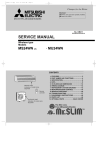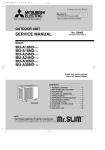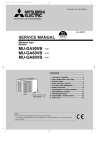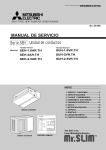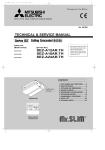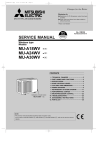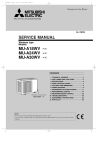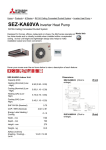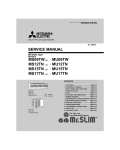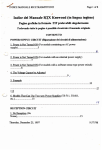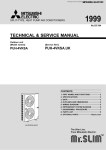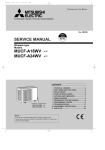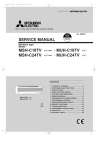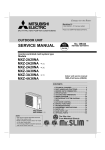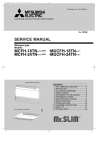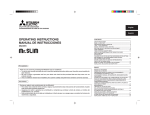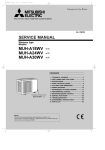Download Mitsubishi MUH24WN Service manual
Transcript
OB310--1.qxp
04.1.13 9:47 AM
Page 1
Revision:
● PARTS LIST have been partially modified.
● Please void OB310.
SPLIT-TYPE, HEAT PUMP AIR CONDITIONERS
No. OB310
REVISED EDITION-A
SERVICE MANUAL
Wireless type
Models
MSH24WN (W)
· MUH24WN
CONTENTS
1. FEATURES ·························································3
2. PART NAMES AND FUNCTIONS······················4
3. SPECIFICATION·················································6
4. DATA···································································8
5. OUTLINES AND DIMENSIONS ·······················13
6. WIRING DIAGRAM ··········································15
7. REFRIGERANT SYSTEM DIAGRAM ··············16
8. MICROPROCESSOR CONTROL ····················17
9. SERVICE FUNCTIONS ····································29
10. TROUBLESHOOTING······································31
11. DISASSEMBLY INSTRUCTIONS·····················44
12. PARTS LIST······················································48
13. OPTIONAL PARTS ······················BACK COVER
INDOOR UNIT
Indication of model name
MSH24WN
Remote
controller
OUTDOOR UNIT
Indication of model name
MUH24WN
The Slim Line.
From Mitsubishi Electric.
TM
C
L IST ED
US
OB310--1.qxp
04.1.13 9:47 AM
Page 2
Revision:
• Parts No. has been changed due to the color change of outdoor unit parts. WHITE➔NEW WHITE (Brighter)
• Capillary tubes have been added to parts list.
Model
Page
MUH24WN
51
MUH24WN
51
Part name
CAPILLARY TUBE (TAPER PIPE)
[0.17X[0.12X11-13/16
CAPILLARY TUBE (TAPER PIPE)
[0.17X[0.12X1-31/32
Part number
E02 785 936
E02 529 936
OB310--1.qxp
04.1.13 9:47 AM
1
Page 3
FEATURES
MSH24WN
MUH24WN
LCD wireless
remote controller
Model
Cooling capacity
Heating capacity
SEER
4/5
5)
HSPF(4
MSH24WN
22,000 Btu/h
23,600 Btu/h
10.0
6.8/5.9
“I FEEL CONTROL” IN OUR LCD WIRELESS REMOTE CONTROLLER WITH ON/OFF PROGRAM TIMER
Mitsubishi Electric’s new wireless remote controller incorporates a number of advanced features that provide even greater control and ease-to-use. It has a liquid crystal display which indicates such information as mode, fan speed and temperature
selected as well as the programmed ON/OFF timer. It is also equipped with “I Feel Control”, a unique Mitsubishi Electric feature that allows the user to adjust the temperature to exactly the level he or she wants simply by tapping the button that
describes present conditions : “Too Cool” or “Too Warm”. The optimum temperature set this way is then memorized for immediate recall whenever the air conditioner is used again.
Select desired air flow direction.
REMOTE-CONTROL OPERATION MODE
Using the remote controller, you can select from five airflow settings to match room layout and the location of people. Also, you
can set the vane to swing automatically.
SWING
SWING
AUTO-RESTART FUNCTION
The auto-restart function restarts the equipment when power is
restored following an outage automatically. Operation resumes in
the mode in which the equipment was running immediately before
the outage.
HIGH PERFORMANCE ROTARY COMPRESSOR
The advanced design of Mitsubishi Electric’s powerful and energy
efficient rotary compressor results in lower operating costs and
longer service life.
3
OB310--1.qxp
2
04.1.13 9:47 AM
Page 4
PART NAMES AND FUNCTIONS
INDOOR UNIT
MSH24WN
Grille
Air inlet
Deodorizing filter (option)
(Gray sponge type)
Air cleaning filter (option)
(White bellows type)
Remote control
receiving section
Front panel
Horizontal vane
Air filter
Remote controller
Vertical vane
Operation section
Display section
(When the grille is opened)
Operation indicator lamp
Operation Indicator
Emergency operation switch
Receiving section
ACCESSORIES
MSH24WN
1
2
3
4
5
6
7
Installation plate
Installation plate fixing screw 4 x 25 mm(0.16 x 0.98 in.)
Remote controller holder
Fixing screw for 3 3.5 x 16 mm(0.14 x 0.63 in.) (Black)
Battery (AAA) for remote controller
Wireless remote controller
Felt tape (Used for left or left-rear piping)
1
7
1
2
2
1
1
OUTDOOR UNIT
MUH24WN
4
OB310--1.qxp
04.1.13 9:47 AM
Page 5
REMOTE CONTROLLER
MSH24WN
Signal transmitting section
Operation display section
PM
OPERATE /STOP
(ON /OFF)button
AM
TOO
ON/OFF WARM
TOO
COOL
TEMPERATURE buttons
Open the front lid.
CLOCK
PM
AM
TOO
ON/OFF WARM
VANE button
(Horizontal vane button)
TOO
COOL
FAN
STOP
VANE
START
I FEEL COOL
FAN SPEED CONTROL button
OFF-TIMER button
HEAT DRY
ON-TIMER button
MODE WIDE VANE
HR.
OPERATION SELECT button
LONG
MIN.
HR. button
MIN. button
(TIME SET button)
RESET CLOCK
CLOCK SET button
WIDE VANE button
(Vertical vane button)
LONG button
RESET button
5
OB310--1.qxp
3
04.1.13 9:47 AM
Page 6
SPECIFICATION
Model
Item
MSH24WN
22,000
23,600
13,500
2,220
2,230
1,730
9.9 (10.0)
6.8 (5.9)
3.10
MSH24WN
White
115V 60Hz 1[
15
1.1
0.82
–
431-491-565
402(346)-484(417)-565(487)
7.3
39-43-47
5/8
43-5/16
8-15/16
12-13/16
40
MUH24WN
Munsell 5Y 7/1
208/230V 60Hz 1[ 3 wires
25
22
0.87
PH33NPBT
C-R 0.84 C-S 2.09
16
58
Linear expansion valve
55
Reverse cycle
34-1/4
11-5/8
33-1/2
154
Wireless type
12V DC
Not supplied (optional parts)
3/8 (0.0285)
5/8 (0.0315)
Flared
Flared
Max. 25
Max. 50
4 Ib. 0 oz.
27.9 (MS32N1)
❈1
Cooling
Btu/h
Heating 47 ❈1
Capacity
Btu/h
Heating 17 ❈2
Btu/h
Cooling ❈1
W
Power
Heating 47 ❈1
W
consumption
Heating 17 ❈2
Cooling
EER ❈1 [SEER] ❈3
Heating
HSPF IV(V)
Heating ❈1
COP
INDOOR UNIT MODEL
External finish
Power supply
A
Max. fuse size (time delay)/ Disconnect switch
Min. circuit ampacity
A
F.L.A
Fan motor
A(kW)
Auxiliary heater
HEAT Dry
CFM
Airflow Low—Med.—High
COOL Dry(Wet)
CFM
pt./h
Moisture removal
Sound level Low-Med.-High
dB(A)
Cond. drain connection O.D.
in.
in.
W
Dimensions
in.
D
in.
H
Weight
Ib.
OUTDOOR UNIT MODEL
External finish
Power supply
Max. fuse size (time delay)
A
Min. circuit ampacity
A
Fan motor
F.L.A
Model
Winding resistance (at 68˚F) Ω
Compressor
R.L.A
L.R.A
Refrigerant control
dB(A)
Sound level
Defrost method
in.
W
Dimensions
in.
D
in.
H
Weight
Ib.
REMOTE CONTROLLER
Control voltage (by built-in transformer)
REFRIGERANT PIPING
Pipe size
Liquid
in.
(Min. wall thickness) Gas
in.
Indoor
Connection method
Outdoor
Height difference
ft.
Between the indoor
Piping length
ft.
& outdoor units
Refrigerant charge (R22)
lb.
Refrigerating oil (Model)
oz.
NOTE : Test conditions are based on ARI 210/240.
❈1 : Rating conditions (cooling) — Indoor : 80˚FDB,
(heating) — Indoor : 70˚FDB,
❈2 :
(heating) — Indoor : 70˚FDB,
❈3 :
(cooling) — Indoor : 80˚FDB,
67˚FWB,
60˚FWB,
60˚FWB,
67˚FWB,
Operating Range
Cooling
Heating
Maximum
Minimum
Maximum
Minimum
Outdoor
Outdoor
Outdoor
Outdoor
:
:
:
:
95˚FDB,
47˚FDB,
17˚FDB,
82˚FDB,
(75˚FWB)
43˚FWB
15˚FWB
65˚FWB
Indoor intake air temperature Outdoor intake air temperature
95˚FDB, 71˚FWB
115˚FDB
67˚FDB, 57˚FWB
67˚FDB
80˚FDB, 67˚FWB
75˚FDB, 65˚FWB
70˚FDB, 60˚FWB
17˚FDB, 15˚FWB
6
OB310--1.qxp
04.1.13 9:47 AM
Page 7
MAX. REFRIGERANT PIPING LENGTH
Piping size : in.
Model
MSH24WN
MUH24WN
Additional piping
Max. length : ft.
A
50
Gas
Length of connecting pipe : in.
Liquid
Minimum
Outside Minimum Outside
Wall
diameter Wall diameter thickness
thickness
[ 5/8
0.0315
[ 3/8
0.0285
Indoor unit
Outdoor unit
Gas : 16-15/16
Liquid : 19-11/16
Gas : 0
Liquid : 0
MAX. HEIGHT DIFFERENCE
Indoor
unit
w Height difference should be within
25ft. regardless of which unit,
indoor or outdoor position is high.
Refrigerant Piping
Max.length
A
w Max. Height
difference 25ft.
Outdoor unit
7
OB310--1.qxp
04.1.13 9:47 AM
Page 8
DATA
4
MSH24WN MUH24WN
4-1. PERFORMANCE DATA
1) COOLING CAPACITY
(208V/ 230V)
Indoor air
Model
IWB
(˚F)
MSH24WN
Outdoor intake air DB temperature(˚F)
85
75
95
105
115
TC
SHC
TPC
TC
SHC
TPC
TC
SHC
TPC
TC
SHC
TPC
TC
SHC
TPC
71
27.0
13.4
1.98
25.2
12.5
2.16
23.7
11.7
2.33
22.0
10.9
2.45
20.2
10.1
2.55
67
25.5
16.1
1.86
23.8
15.0
2.05
22.0
13.9
2.22
20.5
12.9
2.35
18.8
11.9
2.46
63
24.0
18.3
1.78
22.2
17.0
1.96
20.7
15.8
2.12
18.8
14.4
2.26
17.2
13.1
2.35
NOTE 1. IWB : Intake air wet-bulb temperature
TC : Total Capacity (x103 Btu/h), SHC : Sensible Heat Capacity (x103 Btu/h)
TPC : Total Power Consumption (kW)
2. SHC is based on 80˚F of indoor intake air DB temperature.
2) COOLING CAPACITY CORRECTIONS
Refrigerant piping length (one way)
Model
MSH24WN
25ft. (std.)
40ft.
50ft.
1.0
0.954
0.923
3) HEATING CAPACITY
(208V/ 230V)
Indoor air
Model
MSH24WN
IDB
(˚F)
Outdoor intake air WB temperature(˚F)
15
25
35
43
45
55
TC
TPC
TC
TPC
TC
TPC
TC
TPC
TC
TPC
TC
TPC
75
13.7
1.66
17.1
1.95
20.4
2.17
23.0
2.29
23.7
2.32
26.9
2.41
70
14.5
1.61
17.7
1.91
20.9
2.12
23.6
2.23
24.3
2.27
27.5
2.36
65
14.9
1.54
18.5
1.84
21.6
2.06
24.3
2.17
25.0
2.21
28.1
2.32
NOTE: 1. IDB : Intake air dry-bulb temperature
TC : Total Capacity (x103 Btu/h)
TPC : Total Power Consumption (kW)
2. Above data is for heating operation without any frost.
8
OB310--1.qxp
04.1.13 9:47 AM
Page 9
4-2. PERFORMANCE CURVE
MSH24WN
MUH24WN
Cooling
SHF at rating condition = 0.63
Airflow = 487CFM
Bypass Factor = 0.19
30
Ind
oor
Total power consumption (kW)
Total capacity ( ✕10 Btu/h)
28
inta
ke
26
air
WB
24
208V/230V
per
atu
re (
°F)
tem
22
20
71
67
63
18
16
208V/230V
2.6
2.4
°F)
e(
2.2
2.0
ur
rat
pe
em
1.8
1.6
71
67
63
ke
ta
r in
air
t
WB
oo
Ind
65 70 75 80 85 90 95 100 105 110 115
Outdoor intake air DB temperature (°F)
Total power consumption (kW)
Total capacity ( ✕10 Btu/h)
Heating
Airflow = 565CFM
30
28
26
24
22
20
18
16
14
12
10
65
70
75
208V/230V
re
atu
r
pe
r
oo
Ind
ke
inta
air
em
Bt
)
(°F
D
2.6
ture
era
emp
2.4
ake
r int
2.2
Bt
air D
Indo
75
70
65
208V/230V
o
2.0
(°F)
1.8
1.6
15
20 25 30 35 40 45 50 55 60
Outdoor intake air WB temperature (°F)
9
OB310--1.qxp
04.1.13 9:47 AM
Page 10
Data is based on the condition of indoor humidity 50%.
Air flow should be set to High speed.
4-3. Condensing pressure
MSH24WN
(Cooling)
(PSIG)
300
86
80
75
70
280
260
)
ure
Condensing pressure
(PSIG)
100
(°F
t
era
90
p
240
DB
tem
Ind
220
rature (°F)
Suction pressure
r
oo
200
180
86
80
75
70
70
60
50
160
140
68 70
75
80
85
90
95
Outdoor ambient temperature
100
40
68 70
104(°F)
75
80
85
90
95
Outdoor ambient temperature
100
104(°F)
Data is based on the condition of outdoor humidity 75%.
Air flow should be set to High speed.
Data is for heating operation without any frost.
MSH24WN
(Heating)
(PSIG)
340
(PSIG)
90
75
70
65
75
320
300
280
e(
tur
)
°F
70
80
65
70
ra
pe
260
B
rD
Suction pressure
Condensing pressure
Indoor DB tempe
80
tem
oo
Ind
240
220
°F)
e(
ur
rat
60
pe
em
r
oo
Ind
50
t
DB
40
200
30
180
20
160
140
10
5
10
15
20
25 30 35 40 45 50 55
Outdoor ambient temperature
60
65
70(°F)
10
5
10
15
20
25 30 35 40 45 50 55
Outdoor ambient temperature
60
65
70(°F)
OB310--1.qxp
04.1.13 9:47 AM
Page 11
4-4. STANDARD OPERATION DATA
Model
MSH24WN
Unit
Cooling
Heating
Btu / h
22,000
23,600
SHF
—
0.63
–
Input
kW
2.22
2.23
Item
Capacity
Total
Indoor unit
MSH24WN
Power supply
115V 60Hz 1[
kW
0.071
Fan motor current
A
0.62
Aux. heater current
A
–
Input
Electrical
circuit
Outdoor unit
MUH24WN
Power supply
208/230V 60Hz 1[
kW
2.149
2.159
Comp. current
A
9.60 / 8.52
9.65 / 8.56
Fan motor current
A
Input
Refrigerant
circuit
0.67/0.71
250
Condensing pressure
PSIG
257
Suction pressure
PSIG
73
56
Discharge temperature
˚F
180
185
Condensing temperature
˚F
116
115
Suction temperature
˚F
52
35
Comp. shell bottom temp
˚F
163
167
Ref. pipe length
ft.
Refrigerant charge (R22)
25
—
4 lb. 0 oz.
DB
˚F
80
70
WB
˚F
67
60
DB
˚F
53
109
WB
˚F
51
–
Fan speed (High)
rpm
1,280
1,280
Airflow (High)
CFM
487(Wet)
565(Dry)
DB
˚F
95
47
WB
˚F
–
43
Intake air temperature
Indoor
unit
Discharge air temperature
Intake air temperature
Outdoor
unit
Fan speed
rpm
750/820
Airflow
CFM
1,589/1,765
POWER SUPPLY
MSH24WN
•Both wirings can be applied.
115V 60Hz 1[, 2 wires
INDOOR UNIT
SIGNAL
WIRE
2 wires
12V DC
✻ Control voltage
INDOOR UNIT
Disconnect switch
115V 60Hz 1[,
2wires
SIGNAL WIRE
2 wires 12V DC
115V
208/230V 60Hz 1[,
2 wires
OUTDOOR UNIT
208/230V
60Hz 1[,
3 wires
OUTDOOR UNIT
11
Power supply voltage to
serial signal circuit is 12V
DC.
Voltage between 1 - and
3 + on in-out terminal
block will be 12V DC
peak voltage.
OB310--1.qxp
04.1.13 9:47 AM
Page 12
4-5. OPERATING RANGE
(1) POWER SUPPLY
Model
Rating
Guaranteed Voltage
Indoor unit
MSH24WN
115V 60Hz 1[
Outdoor unit
MUH24WN
208/230V 60Hz 1[
Min. 103V
115V Max. 127V
Min. 198V 208V 230V Max. 253V
(2) OPERATION
Intake air
temperature
Function
DB (˚F)
WB (˚F)
DB (˚F)
WB (˚F)
Standard temperature
80
67
95
—
Maximum temperature
95
71
115
—
Minimum temperature
67
57
67
—
Condition
Cooling
—
78%
Maximum humidity
Heating
Outdoor
Indoor
Standard temperature
70
60
47
43
Maximum temperature
80
67
75
65
Minimum temperature
70
60
17
15
4-6. OUTLET AIR SPEED AND COVERAGE RANGE
Air flow Air speed Coverage
(CFM)
(ft./sec.) range (ft.)
Dry
565
HEAT
20.1
34.2
Dry
MSH24WN
565
20.1
34.2
COOL
Wet
487
17.2
29.4
● The air coverage range is the figure up to the position where the air speed is 1 ft./sec., when air is blown out
horizontally from the unit properly at the High speed position.
The coverage range should be used only as a general guideline since it varies according to the size of the room and furniture
arranged inside the room.
Model
Mode
Function
4-7. ADDITIONAL REFRIGERANT CHARGE (R22(oz.))
Model
MSH24WN MUH24WN
Outdoor unit
precharged
(up to 25ft.)
25ft.
30ft.
35ft.
40ft.
45ft.
50ft.
4 lb. 0 oz.
0
1.61
3.22
4.83
6.44
8.05
Refrigerant piping length (one way)
CALCULATION : Xoz. = 1.61/ 5oz./ft. x (Additional Piping Length-25) ft.
12
04.1.13 9:47 AM
5
Page 13
OUTLINES AND DIMENSIONS
MSH24WN
Unit: inch
INDOOR UNIT
3-7/8
6-13/16
16-5/16
3-7/8
1/8
1-7/8
10-1/16
42-1/16
16-5/16
6-13/16
Wall hole [ 2-15/16
8-7/8
3/16
43-5/16
12-13/16
Installation plate
{
Air in
2-3/16
31-1/8
9-15/16
Air out
3/4
6-3/8
2-5/16
Wireless remote controller
13
8-15/16
Liquid line [
Gas line [
Insulation [
[
3/8 19-11/16
3/4 16-15/16
1-15/16 O.D
1-1/4 I.D
Drain hose [ 5/8
(Connected part O.D)
Insulation [ 1-1/8
5/16
Indoor unit
12-3/8
Installation plate
1-7/8
OB310--1.qxp
04.1.13 9:47 AM
Page 14
MUH24WN
OUTDOOR UNIT
Unit: inch
Outdoor Unit-Necessary surrounding clearance
7-7/8
1-9/16 1-1/16
13
14-1/4
Air intake
Air intake
Front opening
9/16
Air outlet
Note:Allow adequate
13/32 upper clearance
13/32
Terminal block for power line
34-1/4
13/32
Terminal block for indoor and outdoor unit connection
11-7/8
19-11/16
5-29/32
7-9/32
19-11/16
11/16
7-9/32
19-11/16
OB310--1.qxp
Service space
Outlet guide
installation hole
Handle for moving
Service panel
Handle for moving
4-1/8
1-5/16
2-1/16
Refrigerant-pipe flared
connection [3/8
Knock out hole
for front piping
(refrigerant,drainage
and wiring)
2-3/8
2-1/2o7/8 Oval holes
(standard bolt M10)
Refrigerant-pipe flared
connection [5/8
1-3/4
21-3/4
17-23/32
33-1/2
20-5/8
1-5/8
1-3/4
1-9/16
17-17/32
18-7/18
20-5/8
7-1/18
17-3/8
A
2-3/8
4-3/4
Knock out holes for
power line 2-[1-1/16
Knock out hole
for right piping
(refrigerant,drainage
and wiring)
Drain hole [1-5/16
Bottom
piping hole
2-U-shaped
notched
holes
Drain hole [1-5/16
9/32
A
Handle
for moving
11-5/8
15/16
Side air intake
Conduit hole
Rear fresh
air intake
R1
Outdoor Unit-Necessary surrounding clearance
(Concentrated installation)
The upper side must be open.
3/
3-1/8
16
/4
11/16
13/32
7-7/8
4
R1
1/2
For 10 units or less
39-3/8
14
1 max.
Rear piping hole
3-3/4
R1
3/1
6
15/16
1-5/16
5-7/16
NOTE: Do not wire12V DC and
115V AC in same conduit hole.
Standard bolt length
2-9/16
Front right piping holesdetail figures
OB310--1.qxp
04.1.13 9:47 AM
6
Page 15
WIRING DIAGRAM
MSH24WN
INDOOR UNIT
(
MODEL WIRING DIAGRAM
4
3
2
1
CN201
TB
3+
ORN
TO OUTDOOR
UNIT
CONNECTING
WIRES
12V DC
FROM OUTDOOR
UNIT
CONNECTING
WIRES
POWER
SUPPLY
115V
1 phase
60Hz
TO OUTDOOR
UNIT
CONNECTING
WIRE
w
1-
VLT
N
BLK
L1
)
HIC1
1
2
3
4
NR11
RED
CN
151
CN
102
15
CN
101
NAME
3
SR141
CN211
CN
RT11
ELECTRONIC CONTROL P.C. BOARD 111
3
3
DISPLAY
P.C.BOARD
RECEIVER
P.C.BOARD
MF
REMOTE
CONTROLLER
SYMBOL
NAME
SYMBOL
MV1
VANE MOTOR(HORIZONTAL)
RT12
INDOOR COIL THERMISTOR(MAIN)
FUSE(3.15A)
MV2
VANE MOTOR(VERTICAL)
RT13
INDOOR COIL THERMISTOR(SUB)
DC/DC CONVERTER
NR11
VARISTOR
INDOOR FAN MOTOR (INNER PROTECTOR)
RT11
ROOM TEMPERATURE THERMISTOR
C11
INDOOR FAN CAPACITOR
F11
MF
RT12
BLK
GRY
YLW
BRN
WHT
RED
1
3
4
C11
F11
TAB12
w A disconnect may be required by local code.
HIC1
CN
121
TRANS
MV2 MV2 MV1
SYMBOL
CN112
RT13
SR141
NAME
SOLID STATE RELAY
TERMINAL BLOCK
TB
SG79J618H02
NOTE:1. About the outdoor side electric wiring, refer to the outdoor unit electric wiring diagram for servicing.
2. Use copper conductors only.(For field wiring)
3. Symbols below indicate;
: Terminal block,
: Connector
LEV
FROM INDOOR UNIT
CONNECTING WIRE
6 5 4 3 2 1 RED
ORN C2
6
1
+
CN661
X62
-
CN662
CN724
X52
1 2 3 CN711
CN721
SR61
X62
COM NO
X52
N
L1
POWER
SUPPLY
208/230V
1 phase 60Hz
N
NAME
GRN/YLW
RED
NR61
C2
OUTDOOR FAN CAPACITOR
SURGE ABSORBER
A2
DSAR
SYMBOL
COMPRESSOR CAPACITOR
DSAR
WHT
BLU
BLU
C1
21S4
1
3
F61
RED
1
GROUND
BLK
TAB52
CN730 5
7
DEICER P.C.BOARD
ORN
VLT
BLU
RED
L2
SYMBOL
NR61
T61
RED
TB1
L1
BLK
COM NO
BLK
TO INDOOR UNIT
CONNECTING
WIRES
115V
1 phase 60Hz
1
2
3
52C
NAME
52C 2
C1
RED S
BLU
TB2
3
FROM INDOOR UNIT
CONNECTING WIRES
12V DC
MF
RT61 RT62 RT63
BLK BLK
WHT WHT
ORN
RED
MUH24WN
MODEL WIRING DIAGRAM
OUTDOOR UNIT
C
MC
R
BLK
A1
SYMBOL
NAME
VARISTOR
T61
TRANSFORMER
RT61
DEFROST THERMISTOR
X52
COMPRESSOR AUXILIARY RELAY
RT62
DISCHARGE TEMPERATURE THERMISTOR
X62
R.V. COIL RELAY
F61
FUSE(3.15A)
RT63
AMBIENT TEMPERATURE THERMISTOR
21S4
R.V. COIL
LEV
EXPANSION VALVE COIL
SR61
SOLID STATE RELAY
52C
COMPRESSOR CONTACTOR
MC
COMPRESSOR(INNER PROTECTOR)
TB1
TERMINAL BLOCK
MF
OUTDOOR FAN MOTOR(INNER PROTECTOR)
TB2
TERMINAL BLOCK
NOTE:1. About the indoor side electric wiring, refer to the indoor unit electric wiring diagram for servicing.
2. Use copper conductors only.(For field wiring)
3. Symbols below indicate;
: Terminal block,
: Connector
15
SG79J604H02
OB310--1.qxp
7
04.1.13 9:47 AM
Page 16
REFRIGERANT SYSTEM DIAGRAM
Unit: inch
MSH24WN
MUH24WN
INDOOR UNIT
Refrigerant pipe [5/8
(with heat insulator)
4-way valve
OUTDOOR UNIT
Strainer
#100
Muffler
Indoor
heat
exchanger
Indoor coil
thermistor
RT12(main)
Flared connection
Indoor coil
thermistor
RT13(sub)
Stop valve
(with service port)
FUSIBLE
PLUG
Discharge
thermistor
RT62
SERVICE
PORT
SERVICE
PORT
Room temperature
thermistor
RT11
Defrost
thermistor
RT61
Outdoor
heat
exchanger
Accumulator
Compressor
Strainer
#50
Flared connection
Check Capillary tube
valve O.D. 0.17✕I.D. 0.12✕11-13/16
LEV
Strainer
Strainer
#100
#100
Stop valve
Refrigerant pipe [3/8
(with heat insulator)
16
Capillary tube
O.D. 0.17✕I.D. 0.12✕1-31/32
Ambient
temperature
thermistor
RT63
R.V. coil
heating ON
cooling OFF
Refrigerant flow in cooling
Refrigerant flow in heating
OB310--1.qxp
04.1.13 9:47 AM
8
Page 17
MICROPROCESSOR CONTROL
MSH24WN MUH24WN
WIRELESS REMOTE CONTROLLER
Signal transmitting section
Once the operation mode is set, the same operation mode
can be repeated by simply turning the OPERATE/STOP
(ON/OFF) button ON.
Indoor unit receives the signal with a beep tone.
When the system turns off, 3-minute time delay will operate to protect system from overload and compressor will
not restart for 3 minutes.
Operation display section
PM
OPERATE /STOP
(ON /OFF)button
AM
TOO
ON/OFF WARM
TOO
COOL
TEMPERATURE buttons
8-1. “I FEEL CONTROL” (
) OPERATION
(1) Press OPERATE/STOP (ON/OFF) button on the
remote controller. OPERATION INDICATOR lamp of
the indoor unit turns on with a beep tone.
(2) Select “I FEEL CONTROL” mode with the OPERATION SELECT button.
(3) The operation mode is determined by the room temperature at start-up of the operation.
CLOCK
Initial room temperature
Mode
77-F or more
COOL mode of
"I FEEL CONTROL"
73-F to 77-F
DRY mode of
"I FEEL CONTROL"
less than 73-F
HEAT mode of
"I FEEL CONTROL"
PM
AM
ON/OFF
VANE button
(Horizontal vane button)
TOO
WARM
TOO
COOL
FAN
STOP
VANE
START
FAN SPEED CONTROL button
I FEEL COOL
OFF-TIMER button
HEAT DRY
ON-TIMER button
MODE WIDE VANE
HR.
OPERATION SELECT button
LONG
MIN.
HR. button
MIN. button
(TIME SET button)
•
Once the mode is fixed, the mode does not change
by room temperature afterwards.
•
Under the ON-TIMER (
) operation, mode is
determined according to the room temperature at the
set time the operation starts.
When the system is stopped on the remote controller,
and restarted within 2 hours in “I FEEL CONTROL”
(
) mode, the system operates in previous mode
automatically regardless of the room temperature.
RESET CLOCK
CLOCK SET button
WIDE VANE button
(Vertical vane button)
LONG button
RESET button
•
INDOOR UNIT DISPLAY SECTION
Operation Indicator lamp
The operation indicator at the right side of the indoor
unit indicates the operation state.
• The following indication applies regardless of shape
of the indicator.
Operation Indicator
Example
Previous operation
COOL mode of
“I FEEL CONTROL”
or COOL mode
lighted
Restart
COOL mode of
“I FEEL CONTROL”
not lighted
Indication
Operation state
This shows that the
air conditioner is
operating to reach
the target temperature.
Please wait unit the
target temperature is
obtained.
This shows that the
room temperature is
approaching the
target temperature.
Difference
between target
temperature
and room
temperature
When the system is restarted after 2 hours and more,
the operation mode is determined by the room temperature at start-up of the operation.
Restart
Example
COOL or DRY or
HEAT mode of “I
Previous operation
FEEL CONTROL”
that determined by
COOL mode of
room temperature
“I FEEL CONTROL”
at start-up of the
or COOL mode
operation.
Approx. 4-F
or more
Approx. 4-F
or less
17
OB310--1.qxp
04.1.13 9:47 AM
Page 18
(4) The initial set temperature is decided by the initial room temperature.
Model
COOL mode of
"I FEEL CONTROL"
Initial room temperature
Initial set temperature
79-F or more
75-F
77-F to 79-F
Initial room temperature
minus 4-F
❈1
DRY mode of
"I FEEL CONTROL"
73-F to 77-F
Initial room temperature
minus 4-F
HEAT mode of
"I FEEL CONTROL"
less than 73-F
79-F
❈1 When the system is restarted with the remote controller, the system operates with the previous set temperature regardless of room temperature at restart.
The set temperature is calculated by the previous set temperature.
(5) TEMPERATURE buttons
In “I FEEL CONTROL” (
) mode, set temperature is decided by the microprocessor based on the room temperature.
In addition, set temperature can be controlled by TOO WARM or TOO COOL buttons when you feel too cool or too warm.
Each time the TOO WARM or TOO COOL button is pressed, the indoor unit receives the signal and emits a beep tone.
• Fuzzy control
When the TOO COOL or TOO WARM button is pressed, the microprocessor changes the set temperature, considering
the room temperature, the frequency of pressing TOO COOL or TOO WARM button and the user’s preference to heat or
cool. So this is called “Fuzzy control”, and works only in “I FEEL CONTROL” mode.
In DRY mode of “I FEEL CONTROL”, the set temperature doesn’t change.
TOO
COOL
TOO
WARM
… To raise the set temperature 2~4 degrees(°F)
… To lower the set temperature 2~4 degrees(°F)
8-1-1. COOL mode of “I FEEL CONTROL”
1. Indoor fan speed control
Indoor fan operates at the set speed by FAN SPEED CONTROL button.
In AUTO the fan speed is as follows.
Initial temperature difference
Fan Speed
Room temperature minus set temperature : 3 degrees or more·····························High
Room temperature minus set temperature : Between 2 and 3 degrees··················Med.
Room temperature minus set temperature : less than 2 degree·····························Low
Difference between room
temperature and set temperature
during operation
4deg.
2deg.
3deg.
2. Coil frost prevention
① Temperature control
When the indoor coil thermistor RT12 or RT13 reads 30°F or below the coil frost prevention mode starts immediately.
However, the coil frost prevention doesn’t work for 5 minutes since the compressor has started.
The indoor fan operates at the set speed and the compressor stops for 5 minutes.
After that, if RT12 or RT13 still reads below 30°F this mode prolonged until the RT12 or RT13 still reads over 30°F.
② Time control
When the three conditions as follows have been satisfied for 1 hour and 45 minutes, compressor stops for 3 minutes.
a. Compressor has been continuously operating.
b. Indoor fan speed is Low or Med.
c. Room temperature is below 79°F.
When compressor stops, the accumulated time is cancelled and when compressor restarts, time counting starts from the
beginning.
Time counting also stops temporarily when the indoor fan speed becomes High or the room temperature exceeds
79°F. However, when two of the above conditions (b.and c.) are satisfied again. Time accumulation is resumed.
18
OB310--1.qxp
04.1.13 9:47 AM
Page 19
Operation chart
Example
Compressor
Outdoor fan
Indoor fan
ON
ON
OFF
OFF
ON (continuously at set speed)
3. Discharge temperature protection
The compressor is controlled by the temperature of discharge temperature thermistor RT62 for excess rise protection of
compressor discharge pressure.
• Compressor
When the temperature of discharge temperature thermistor RT62 goes to 248°F or more, the compressor is turned OFF.
After 3 minutes since the compressor has been turned OFF, if the temperature of discharge temperature thermistor RT62
becomes 212°F or less, the compressor is turned ON.
8-1-2. DRY mode of “I FEEL CONTROL”
The system for dry operation uses the same refrigerant circuit as the cooling circuit.
The compressor and the indoor fan are controlled by the room temperature.
By such controls, indoor flow amounts will be reduced in order to lower humidity without much room temperature
decrease.
1. Indoor fan speed control
Indoor fan operates at the set speed by FAN SPEED CONTROL button.
However, in AUTO fan operation, fan speed becomes Low.
2. The operation of the compressor and indoor/ outdoor fan
Compressor operates by room temperature control and time control.
Set temperature is controlled to fall 4°F from initial room temperature.
Indoor fan and outdoor fan operate in the same cycle as the compressor.
•When the room temperature is 73°F or over:
When the thermostat is ON, the compressor repeats 8 minutes ON and 3 minutes OFF.
When the thermostat is OFF, the compressor repeats 4 minutes OFF and 1 minute ON.
•When the room temperature is under 73°F.
When the thermostat is ON, the compressor repeats 2 minutes ON and 3 minutes OFF.
When the thermostat is OFF, the compressor repeats 4 minutes OFF and 1 minute ON.
Operation time chart
ON
ON
Example
OFF
OFF
Thermostat
Indoor fan
OFF
OFF
ON
Outdoor fan
Compressor
OFF
OFF
ON
OFF
8 min.
ON
ON
ON
ON
OFF
3 min. 4 min.
1 min.
3. Coil frost prevention
• The operation is as same as coil frost prevention during COOL mode of “I FEEL CONTROL”.
• Indoor fan operates at the set speed and the compressor stops for 5 minutes, because protection(Coil frost
prevention) has the priority.
However, when coil frost prevention works while the compressor is not operating, it’s speed becomes Low.
19
OB310--1.qxp
04.1.13 9:47 AM
Page 20
8-1-3. HEAT mode of “I FEEL CONTROL”
1. Indoor fan speed control
Initial temperature difference
Fan speed
Difference between room
temperature and set temperature
during operation
(1) In AUTO the fan speed is as follows.
Set temperature minus room temperature: 4 degrees or more················································· High
Set temperature minus room temperature: Between 2 and 4 degrees ····································· Med.
4deg. 7deg.
Set temperature minus room temperature: less than 2 degree················································· Low
2deg.
3deg.
(2) Cold air prevention control
The fan runs at set speed when the indoor coil thermistor RT12 temperature exceeds 72°F. The fan operates Low when
the temperature of indoor coil thermistor RT12 is below 64°F. But the fan stops when the indoor fan operates at Very
Low and the room temperature is 59°F or less.
Fan speed
Indoor coil thermistor
Released
Set speed
RT12 temperature
Cold Air Prevention
Very Low or stop
64F- 72F-
NOTE : If the temperature of RT12 reads from 64°F to 72°F at the air conditioner starting and also after defrosting, this
control works.
(3) Warm air control.
When compressor starts in heating operation or after defrosting, the fan changes the speed due to the indoor coil thermistor RT12 temperature to blow out warm air.
After releasing of cold air prevention, when the indoor coil thermistor RT12 temperature is 99°F or above, the fan speed
shifts to the set speed, and when the fan speed is changed by the remote controller, the fan speed is the set speed.
When the indoor coil thermistor RT12 temperature is less than 99°F, the fan speed is controlled by time as below.
<Time condition>
<Indoor fan speed>
less than 2 minutes ························Low
2 minutes to 4 minutes···················Med.
4 minutes or more ··························High
The upper limit of the fan speed is the set speed.
If the thermostat turns off, this operation changes to flow soft control.
(4) Flow soft control
After the thermostat turns off, the indoor fan operates at Very Low.
NOTE : When the thermostat turns on, the fan operates at the set speed. Due to the cold air prevention control, the fan
does not start at set speed until the indoor coil thermistor RT12 reads 72°F or more.
2. High pressure protection
During heating operation, the outdoor fan and the compressor are controlled by the temperature of indoor coil thermistor
RT12 for excess rise protection of compressor discharge pressure.
• Outdoor fan
When the temperature of indoor coil thermistor RT12 goes to 131°F or more, the outdoor fan is turned OFF.
When the temperature of indoor coil thermistor RT12 becomes to 126°F or less, the outdoor fan is turned ON.
• Compressor
When the temperature of indoor coil thermistor RT12 goes to 167°F or more, the compressor is turned OFF.
3 minutes after the compressor is turned OFF and if the temperature of indoor coil thermistor RT12 becomes 167°F or
less, the compressor is turned ON.
NOTE : During the high pressure protection and for 10 seconds after high pressure protection, defrosting of outdoor heat
exchanger is not detected by the defrost thermistor RT61.
3. Discharge temperature protection
Discharge temperature protection is as same as during COOL mode of “I FEEL CONTROL”.
20
OB310--1.qxp
04.1.13 9:47 AM
Page 21
4. Defrosting
Defrosting of outdoor heat exchanger is controlled by deicer P.C. board, with detection by the defrost thermistor RT61.
(1) Starting conditions of defrost
When all conditions of a) ~ c) are satisfied, the defrosting operation starts.
a) Under the heat operation, the compressor cumulative operation time exceeds 40 minutes without the defrosting operation working.
b) The defrost thermistor RT61 reads 27°F or less.
c) After releasing the high pressure protection 4 minutes and 10 seconds have elapsed.
(2) Releasing conditions of defrost
When the condition d) or e) is satisfied, the defrosting operation stops.
d) The defrost thermistor RT61 reads 56°F or more.
e) The defrosting time exceeds 10 minutes.
(3) Defrosting time chart
Defrost thermistor RT61
56°F or more
27°F or less
Outdoor 52C
contactor
(Compressor)
ON
OFF
15 sec.
X62
(R.V. coil)
ON
SR61
Outdoor fan
ON
Defrost
counter
ON
Indoor fan
Indoor vane
OFF
30 sec.
30 sec.
5 sec.
OFF
OFF
ON
Very Low
OFF
Max 10 min.
NOTE1
Horizontal
Set position
NOTE1 • When the indoor coil thermistor RT12 reads above 64°F, indoor fan operates at Very Low for 30 seconds.
• When the indoor coil thermistor RT12 reads 64°F or less, the indoor fan stops.
21
OB310--1.qxp
04.1.13 9:47 AM
Page 22
5. R.V. coil control
Heating · · · · · ON
Cooling · · · · · OFF
Dry · · · · · · · · OFF
NOTE: The 4-way valve reverses for 5 seconds right before start-up of the compressor.
Compressor
R.V. coil
Outdoor fan
8-2. COOL (
(COOL / DRY)
(HEAT)
5 sec.
5 sec.
ON
OFF
) OPERATION
) OPERATION
(1) Press OPERATE/STOP (ON/OFF) button.
OPERATION INDICATOR lamp of the indoor unit
turns on with a beep tone.
(2) Select DRY mode with the OPERATION SELECT
button.
(3) The microprocessor reads the room temperature
and determines the set temperature. Set temperature is as shown on the right chart.
Thermostat (SET TEMP.)does not work.
The other operations are same as DRY mode of “I
FEEL CONTROL”.
(4) DRY operation will not function when the room temperature is 55°F or below.
8-4. HEAT (
ON
OFF
ON
OFF
(1) Press OPERATE/STOP (ON/OFF) button.
OPERATION INDICATOR lamp of the indoor unit turns
(2) Select COOL mode with the OPERATION SELECT
button.
(3) Press TEMPERATURE buttons.
(TOO WARM or TOO COOL button) to select the
desired temperature.
The setting range is 59 ~ 89°F.
✻ Indoor fan continues to operate regardless of
thermostat’s OFF-ON at set speed.
✻ Coil frost prevention is as same as COOL mode
of “I FEEL CONTROL”.
8-3. DRY (
ON
OFF
ON
OFF
ON
OFF
on with a beep tone.
-F
95
86
77
68
59
50
50
59
68
77
86
95 -F
) OPERATION
(1) Press OPERATE/STOP (ON/OFF) button.
OPERATION INDICATOR lamp of the indoor unit turns on with a beep tone.
(2) Select HEAT mode with the OPERATION SELECT button.
(3) Press TEMPERATURE buttons (TOO WARM or TOO COOL button) to select the desired temperature.
The setting range is 59 ~ 89°F.
(4) Indoor fan speed control, high pressure protection, defrosting, R.V. coil control are the same as HEAT mode of “I FEEL
CONTROL”.
22
OB310--1.qxp
04.1.13 9:47 AM
Page 23
8-5. INDOOR FAN MOTOR CONTROL
(1) Rotational frequency feedback control
The indoor fan motor is equipped with a rotational frequency sensor, and outputs signal to the microprocessor to feed
back the rotational frequency. Comparing the current rotational frequency with the target rotational frequency
(High, Med., Low), the microprocessor controls SR141 and adjusts fan motor electric current to make the current
rotational frequency close to the target rotational frequency. With this control, when the fan speed is switched, the
rotational frequency changes smoothly.
Rotational frequency
High
High
Med.
Low
time
(2) Fan motor lock-up protection
When the rotational frequency feedback signal has not output for 12 seconds, (or when the microprocessor cannot
detect the signal for 12 seconds) the fan motor is regarded locked-up. Then the electric current to the fan motor is shut
off. 3 minutes later, the electric current is applied to the fan motor again. During the fan motor lock-up, the OPERATION
INDICATOR INDICATOR lamp flashes on and off to show the fan motor abnormality. (Refer to page 33.)
8-6. AUTO VANE OPERATION
1. Horizontal vane
(1) Vane motor drive
This model is equipped with a stepping motor for the horizontal vane. The rotating direction, speed, and angle of
the motor are controlled by pulse signals (approx. 12V) transmitted from indoor microprocessor.
(2) The horizontal vane angle and mode changes as follows by pressing the VANE button.
AUTO
1
Horizontal
2
3
Middle
4
5
Downward
Swing
(3) Positioning
The vane is once pressed to the vane stopper below to confirm the standard position and then set to the desired angle.
Confirming of standard position is performed in case of follows.
(a) When the OPERATE/STOP (ON/OFF) button is pressed.
(b) When the vane control is changed from AUTO to MANUAL.
(c) When the SWING is finished.
(d) When the test run starts.
(e) When the power supply turns ON.
(4) VANE AUTO (
) mode
In VANE AUTO mode, the microprocessor automatically determines the vane angle and operation to make the optimum
room-temperature distribution.
① In COOL and DRY operation
Vane angle is fixed to Angle 1.
➁ In HEAT operation
Vane angle is fixed to Angle 4.
23
OB310--1.qxp
04.1.13 9:47 AM
Page 24
(5) STOP (operation OFF) and ON-TIMER standby.
When the following cases occur, the horizontal vane returns to the closed position.
(a) When the OPERATE/STOP (ON/OFF) button is pressed (POWER OFF).
(b) When the operation is stopped by the emergency operation.
(c) When the ON-TIMER is on standby.
(6) Dew prevention
During COOL or DRY operation at Vane Angle 4 or 5 when the cumulative operation time of compressor exceeds 1
hour, the vane angle automatically changes to Angle 1 for dew prevention.
(7) SWING MODE ( )
By selecting SWING mode with the VANE button, the horizontal vane swings vertically. The remote controller displays
“ ”.
(8) Cold air prevention in HEAT operation
When any of the following conditions occurs in HEAT operation, the vane angle changes to Angle 1
automatically to prevent cold air blowing on users.
① Compressor is not operating.
➁ Defrosting is performed.
➂ Indoor coil thermistor RT12 reads 75°F or below.
➃ Indoor coil thermistor RT12 temperature is raising from 75°F or below, but it does not exceed 82°F.
Horizontal vane
Released
Indoor coil thermistor RT12 temperature
Set position
Cold Air Prevention
75F-
82F-
Angle 1
NOTE: If the temperature of RT12 reads from 75°F to 82°F at the air conditioner starting, this control works.
(9) LONG MODE (
)
By pressing the LONG button fan speed becomes faster than setting fan speed on the remote controller, and the
horizontal vane moves to the position for LONG mode. The remote controller displays “
when the LONG button is pressed once again or the VANE button is pressed.
• In the following example, the vertical vane is set to
”. LONG mode is cancelled
(front.).
COOL / DRY
HEAT
Fan speed : Faster
Solid arrow : When the LONG mode is used.
Dotted arrow : When the LONG mode is not used.
2. Vertical vane
(1) Vane motor drive
This model is equipped with a stepping motor for the vertical vane. The rotating direction, speed, and angle of the motor
are controlled by pulse signals (approx. 12V) transmitted from microprocessor.
(2) The vertical vane angle and mode change as follows by pressing the WIDE VANE button.
1
2
4
3
Air flow direction
Air flow blowing range
24
SWING
5
6
OB310--1.qxp
04.1.13 9:47 AM
Page 25
(3) Positioning
The vane is once pressed to the vane stopper to confirm the standard position and then set to the desired angle.
Confirming of standard position is performed under following conditions.
(a) When the OPERATE/STOP(ON/OFF) button is pressed (POWER ON/OFF).
(b) When the SWING is started or finished.
(c) When the power supply turns ON.
(4) SWING MODE ( )
By selecting SWING mode with the WIDE VANE button, the vertical vane swings horizontally. The remote controller
displays “
”. The vane moves right and left in the width of Angle 4 repeatedly.
(5) WIDE MODE (
)
By selecting WIDE mode with the WIDE VANE button, indoor fan speed becomes faster than setting fan speed on the
remote controller (W). The remote controller displays “
”.
NOTE : The position of vane angle 3, angle 4 and angle 5 are different in COOL operation and HEAT operation.
W Indoor fan speed becomes faster than setting fan speed on the remote controller even when
or
selected.
is
Horizontal AIR FLOW blowing range
About 100COOL and DRY
About 150HEAT
8-7. TIMER OPERATION
1. How to set the timer
(1) Press OPERATE/STOP (ON/OFF) button to start the air conditioner.
(2) Check that the current time is set correctly.
NOTE : Timer operation will not work without setting the current time. Initially “AM0:00” blinks at the current time display of
TIME MONITOR, so set the current time correctly with CLOCK SET button.
(3) Press TIMER CONTROL button to select the operation.
“ON-TIMER” button... AUTO START operation (ON timer)
“OFF-TIMER” button... AUTO STOP operation (OFF timer)
(4) Press HR. and MIN. button to set the timer. Time setting is 10-minute units.
HR. and MIN. button will work when “
” or “
” mark is flashing.
These marks disappear in 1 minute.
After setting the ON timer, check that OPERATION INDICATOR lamp of the indoor unit lights.
NOTE1 : Be sure to place the remote controller at the position where its signal can reach the air conditioner even during
TIMER operation, or the set time may deviate within the range of about 10 minutes.
NOTE2 : Reset the timer in the following cases, or the set time may deviate and other malfunctions may occur.
• A power failure occurs.
•The circuit breaker functions.
2. Cancel
TIMER setting can be cancelled with the ON/OFF TIMER buttons.
To cancel the ON timer, press the “ON-TIMER” button.
To cancel the OFF timer, press the “OFF-TIMER” button.
TIMER is cancelled and the display of set time disappears.
25
OB310--1.qxp
04.1.13 9:47 AM
Page 26
PROGRAM TIMER
• The OFF timer and ON timer can be used in combination.
• “ ” and “ ” display shows the order of the OFF timer and ON timer operation.
(Example 1) The current time is 8:00 PM.
(Example 2) The current time is 11:00 AM.
The unit turns off at 11:00 PM, and on at 6:00 AM.
The unit turns on at 5:00 PM, and off at 9:00 PM.
PM
PM
AM
PM
NOTE : TIMER setting will be cancelled by power failure or breaker functioning.
8-8. EMERGENCY-TEST OPERATION
In case of test run operation or emergency operation, use the EMERGENCY OPERATION switch on the front of the
indoor unit. Emergency operation is available when the remote controller is missing, has failed or the batteries of remote
controller run down. The unit will start and the OPERATION INDICATOR lamp will light.
The first 30 minutes of operation is the test run operation. This operation is for servicing. The indoor fan speed runs at
High speed and the system is in continuous operation. (The thermostat is ON.)
After 30 minutes of test run operation the system shifts to EMERGENCY COOL / HEAT MODE with a set temperature of
75°F.
The fan speed shifts to Med. speed.
The coil frost prevention works even in emergency operation, and defrosting too.
In the test run or emergency operation, the horizontal vane operates in VANE AUTO (
) mode.
Emergency operation continues until the EMERGENCY OPERATION switch is pressed once or twice or the unit receives
any signal from the remote controller. In case of latter normal operation will start.
NOTE : Do not press the EMERGENCY OPERATION switch during normal operation.
• The following indication applies regardless
of shape of the indicator.
OPERATION INDICATOR lamp
EMERGENCY OPERATION switch
26
Press once
<Cool>
Press again
<Heat>
Press once again
<Stop>
OB310--1.qxp
04.1.13 9:47 AM
Page 27
8-9. LEV control
General operation
Basic specification
LEV (Expansion valve) is controlled by “Thermostat ON” commands given from the unit.
Controlled range
Minimum : 54 pulse, Maximum : 500 pulse
Drive speed
30 ~ 90 pulse / second
Opening set
The setting is always in opening direction.
(To close the LEV, it is closed to the pulse smaller than the one which is
set finally. Then the LEV is opened to the final setting pulse.)
Stop of indoor unit
Opening in stop : 150 pulse ➔ LEV opening is set to becomes 500 pulse
after 3 minutes passed.
Remote controller ON
LEV positioning (LEV is closed completely at once)
Power ON (Breaker ON)
LEV is positioned. However, afterwards, LEV is not positioned at the first
remote controller ON.
Approximate for 2 minutes since
compressor has started.
Opening is set by the initial opening.
(Initial opening is set according to each operation modes and
outer temperature conditions.)
From approximate 2 minutes to
approximate 13 minutes
(for 11 minutes) since compressor
has started.
Opening is set by standard opening.
(Standard opening is set according to each operation modes and
outer temperature conditions.)
After 13 minutes passed since
compressor has started.
LEV opening is corrected to be once every 2 minutes so that discharge
temperature becomes the target discharge temperature.
(When the discharge temperature is lower than target one : LEV is corrected in
closed direction, when the discharge temperature is higher than target one :
LEV is corrected in opening direction.)
At thermostat OFF
Opening in stop : 150 pulse ➔ LEV is set to the initial opening after about
3 minutes passed.
At thermostat ON
Same as the starting of compressor operation
At remote controller OFF
Opening in stop : 150 pulse ➔ LEV is set so that the opening is opened
completely at the speed of 4 pulse every 5 seconds in opening after about
3 minutes passed.
(1) LEV opening correction by discharge temperature
The LEV opening is corrected according to the temperature difference between target discharge temperature (Tb) and
actual discharge temperature (Ta).
1 The LEV correction is used properly for two kinds according to the LEV opening status at operation off.
Opening immediately before having stopped last time
Rank
100 pulse or less
(Pulse)
100 pulse or more
(Pulse)
Ta (F-)
Cooling / Heating
Cooling / Heating
more than Tb+18
5
20
Tb+9 to Tb+18
2
10
Tb+4 to Tb+9
1
2
Tb-4 to Tb+4
0
0
Tb-9 to Tb-4
-1
-2
Tb-18 to Tb-9
-2
-5
less than Tb-18
-5
-10
NOTE : Discharge temperature : Ta, Target discharge temperature : Tb
27
OB310--1.qxp
04.1.13 9:47 AM
Page 28
2 When the temperature difference
RT between indoor coil thermistor (main) RT12 and indoor coil thermistor (sub)
RT13 in the indoor unit is 4deg. or more for a fixed time at cool or dry operation, the target discharge temperature is
changed. After the temperature is changed, when temperature difference
RT is 6deg. or more, the target
temperature is changed again. The LEV opening is controlled based on the changed target discharge temperature
and the temperature difference
RT.
RT
Ta (F-)
less than 4deg.
(Pulse)
4deg. or more and less than 6deg.
(Pulse)
6deg. or more
(Pulse)
more than Tb+18
20
60
60
Tb+9 to Tb+18
10
20
20
Tb+4 to Tb+9
2
10
10
Tb-4 to Tb+4
0
0
0
Tb-9 to Tb-4
-2
-2
-2
Tb-18 to Tb-9
-5
-5
-5
less than Tb-18
-10
-10
-10
NOTE : Discharge temperature : Ta, Target discharge temperature : Tb
The target discharge temperature (Tb) is set according to the operation mode or the unit status as follows.
Tb (-F)
Operation mode
HEAT
180
COOL (Normal)
176
COOL (
RT is less than 4deg., or
COOL (
RT is 6deg. or more.)
RT is 4deg. or more and less than 6deg..)
144
136
NOTE : Target discharge temperature : Tb
NOTE : When the discharge temperature (Ta) is 122°F or less on the cool operation, or is 120°F or less on heat operation,
LEV opening is set in 54 pulse.
When this state continues for 20 minutes, the compressor is stopped and restarts in 3 minutes.
When the compressor is stopped, the indoor unit indicates the abnormality of refrigerant system and stops.
(OPERATION INDICATOR lamp is 10-time flashing on and off.)
(2) LEV time chart
LEV opening
Open
Close
Opening
Power ON completely
Operation
Remote
➔ controller
ON
Standard opening
Initial opening
Positioning
Thermostat
OFF
Remote Opening ➔ Remote
controller completely controller
ON
Operation OFF
Standard opening
Thermostat
ON
Operation
Standard opening
Initial opening
Initial opening
Opening in stop
Opening in stop
Positioning
NOTE : Opening increases and decreases to be in the target discharge temperature during operation.
28
Time
OB310--1.qxp
04.1.13 9:47 AM
9
Page 29
SERVICE FUNCTIONS
MSH24WN MUH24WN
9-1. COMPULSORY DEFROSTING MODE FOR SERVICE
By short circuit of the connector JPG1 and R871 on the outdoor deicer P.C. board, defrosting mode can be accomplished
regardless of the defrost interval restriction.
Defrost thermistor RT61 must read below 27°F. (Refer to page 42.)
9-2. CHANGE IN DEFROST SETTING
<JRF> When the JRF wire of the deicer P.C. board is cut, the defrost interval time is changed.
<JRG> When the JRG wire of the deicer P.C. board is cut, the defrost temperature is changed. (Refer to page 42.)
Model
Change point
Jumper wire
JRF
Defrost interval time changes from 40 minutes to 15minutes.
JRG
Defrost start temperature does not change (27˚F).
Defrost finish temperature changes from 56˚F to 59˚F.
MUH24WN
9-3. TIMER SHORT MODE
For service, set time can be shortened by short circuit of JPG and JPS the electronic control P.C. board.
The time will be shortened as follows. (Refer to page 41.)
Set time : 1 minute ➔ 1-second
Set time : 3 minute ➔ 3-second (It takes 3 minutes for the compressor to start operation. However, the starting time is
shortened by short circuit of JPG and JPS.)
9-4. P.C. BOARD MODIFICATION FOR INDIVIDUAL OPERATION
A maximum of 4 indoor units with wireless remote controllers can be used in a room.
In this case, to operate each indoor unit individually by each remote controller, P.C. boards of remote controller must be
modified according to the indoor unit number.
How to modify the remote controller P.C. board
Remove batteries before modification.
The board has a print as shown below :
NOTE : For remodelling, take out the
batteries and press the
OPERATE/STOP(ON/OFF)button
twice or 3 times at first.
After finish remodelling, put back
the batteries then press the
RESET button.
The P.C. board has the print “J1” and “J2”. Solder “J1” and “J2” according to the number of indoor unit as shown in Table 1.
After modification, press the RESET button.
29
OB310--1.qxp
04.1.13 9:47 AM
Page 30
Table 1
1 unit operation
2 units operation
3 units operation
4 units operation
No. 1 unit
No modification
Same as at left
Same as at left
Same as at left
No. 2 unit
–
Solder J1
Same as at left
Same as at left
No. 3 unit
–
–
Solder J2
Same as at left
No. 4 unit
–
–
–
Solder both J1 and J2
How to set the remote controller exclusively for particular indoor unit
After you turn the breaker ON, the first remote controller that sends the signal to the indoor unit will be regarded as the
remote controller for the indoor unit.
The indoor unit will only accepts the signal from the remote controller that has been assigned to the indoor unit once they are
set. The setting will be cancelled if the breaker has turned off, or the power supply has shut down.
Please conduct the above setting once again after the power has restored.
9-5. AUTO RESTART FUNCTION
When the indoor unit is controlled with the remote controller, the operation mode, the set temperature, and the fan
speed are memorized by the indoor electronic control P.C. board.
When the main power is turned off and then turned back on, the unit restarts automatically in the memorized set
conditions approximately after 3 minutes.
How to release “AUTO RESTART FUNCTION”
1 Turn off the main power for the unit.
2 Pull out the indoor electronic control P.C. board and the display P.C.board. (Refer to page 44.)
3 Solder the Jumper wire or the Resistor 220Ω to the JR07 on the indoor electronic control P.C.board.
C11
CN
21
1
CN201
TAB12
SW1
RA102
CN151 CN121
CN111
CN112
(Refer to page 41.)
Operation
1 If the main power (115V AC) has been cut, the operation settings
remain.
2 After the power is restored, the unit restarts automatically according to
the memory.(However, it takes at least 3 minutes for the compressor
to start running.)
IC101
IC152
JR07
NOTE:
•The operation settings are memorized when 10 seconds have passed after the indoor unit was operated with the remote
controller.
•If the main power is turned off or a power failure occurs while AUTO START/STOP timer is active, the timer setting is
cancelled.
•If the unit has been off with the remote controller before power failure, the auto restart function does not work as the
power button of the remote controller is off.
•To prevent breaker off due to the rush of starting current, systematize other home appliances not to turn on at the same
time.
•When some air conditioners are connected to the same supply system, if they are operated before power failure, the
starting current of all the compressors may flow simultaneously at restart.
Therefore, special counter-measures are required to prevent the main voltage-drop or the rush of the starting current
by adding to the system that allows the units to start one by one. (time delay)
30
OB310--2.qxp
04.1.13 9:49 AM
10
Page 31
TROUBLESHOOTING
MSH24WN MUH24WN
10-1. Cautions on troubleshooting
1. Before troubleshooting, check the following:
1) Check the power supply voltage.
2) Check the indoor/outdoor connecting wire for mis-wiring.
2. Take care the following during servicing.
1) Before servicing the air conditioner, first be sure to turn off the remote controller to stop the unit, and then after confirming the horizontal vane is closed, turn off the breaker and / or disconnect the power plug.
2) Be sure to turn OFF the power supply before removing the front panel, the cabinet, the top panel, and the electronic
control P.C. board.
3) When removing the electronic control P.C. board, hold the edge of the board with care NOT to apply stress on the
components.
4) When connecting or disconnecting the connectors, hold the housing of the connector. DO NOT pull the lead wires.
Housing point
Lead wiring
3. Troubleshooting procedure
1) First, check if the OPERATION INDICATOR lamp on the indoor unit is flashing on and off to indicate an abnormality.
To make sure, check how many times the abnormality indication is flashing on and off before starting service work.
2) Before servicing check that the connector and terminal are connected properly.
3) If the electronic control P.C. board is supposed to be defective, check the copper foil pattern for disconnection and the
components for bursting and discoloration.
4) When troubleshooting, refer to the flow chart on page 32 and the check table on page 33.
4. How to replace batteries
Weak batteries may cause the remote controller malfunction.
In this case, the remote controller can be repaired only by the battery replacement. To operate the remote controller normally, replace the batteries in the following order.
This remote controller has the RESET button. After refilling new batteries, press the RESET button with tip end of ball
point pen or the like, and then use the remote controller.
1 Remove the front lid and insert batteries.
Then reattach the front lid.
2 Press the RESET button.
Insert the negative pole
of the batteries first.
Check if the polarity of
the batteries are correct.
RESET button
NOTE : If the RESET button is not pressed, the remote controller may not operate correctly.
31
OB310--2.qxp
04.1.13 9:49 AM
Page 32
10-2. Instruction of troubleshooting
Start
Indoor unit
operates.
Outdoor unit
doesn't
operate.
Outdoor unit
operates in
only Test Run
operation.
Outdoor unit
doesn't
operate
even in
Test Run
operation.
Indoor unit
operates.
Outdoor unit
doesn't operate
normally.
Outdoor unit
doesn't
stop even
if indoor unit
stops.
OPERATION
INDICATOR
lamp on the
indoor unit is
flashing on
and off.
Indoor unit
doesn't receive
the signal from
remote controller.
Unit doesn't
operate
normal
operation in
COOL or
HEAT mode.
Indoor unit
operates, when
the EMERGENCY
OPERATION
switch is pressed.
Refer to B
"Check of
remote controller
and receiver
P.C. board"
on page 35.
Indoor unit
doesn't operate,
when the
EMERGENCY
OPERATION
switch is pressed.
Check room
temperature
thermistor.
Refer to
"Test point
diagram and
voltage" on
page 41.
Refer to D
"Check of
outdoor unit"
on page 37.
Flash on and
off at 0.5second
intervals
Cause:
Indoor/
Outdoor unit
• Mis-wiring
2-time flash
Cause:
Indoor unit
• Trouble of
room temperature/
indoor coil
thermistor
3-time flash
Cause:
Indoor unit
• Trouble of
indoor fan
motor
4-time flash
Cause:
Indoor unit
• Trouble of
indoor unit
control
system
6-time flash
Cause:
Outdoor unit
• Trouble of
thermistor
in outdoor
unit
7-time flash
Cause:
Outdoor unit
• Trouble of
outdoor
control
system
10-time flash
Cause:
Outdoor unit
• Trouble of
low
discharge
temperature
protection
Refer to G
"How to check
mis-wiring
(When
outdoor unit
doesn't
operate)"
on page 39.
Check room
temperature
thermistor
and indoor
coil thermistor.
Refer to
"Test point
diagram and
voltage"
on page 41.
Refer to A
"Check of
indoor fan
motor"
on page 35.
Replace the
indoor
electronic
control
P.C. board.
Refer to I
"Check of
outdoor
thermistor"
on page 40.
Replace the
deicer
P.C. board.
Refer to H
"Check of
LEV"
on page 40.
Refer to E
"Check of
outdoor unit"
on page 38.
Refer to F
"Check of
R.V. coil"
on page 38.
32
1. Check indoor /
outdoor
connecting wire.
2. Refer to C
"Check of indoor
electronic control
P.C. board"
on page 36.
OB310--2.qxp
04.1.13 9:49 AM
Page 33
1. Troubleshooting check table
• The following indication applies regardless of shape of the indicator.
flashing
· Flashing of the OPERATION INDICATOR lamp (on the left-hand side) indicates possible
abnormalities.
· The OPERATION INDICATOR lamp (on the left-hand side) is lighting during normal operation.
Operation Indicator
Before taking measures, make sure that the symptom reappears, for accurate troubleshooting.
Self check table
No.
Abnormal
point
Operation indicator lamp
Symptom
0.5-second ON
Outdoor unit
does not
operate.
1 Mis-Wiring
Detection method
Checkpoint
3 minutes after power supply turns ON, when
serial signal is not received.
• Refer to G "How to check
mis-wiring" on page 39.
Detect Indoor coil/room temperature thermistor
short or open circuit every 8 seconds during
operation.
• Refer to the characteristics of
main indoor coil thermistor,
sub indoor coil thermistor,
and room temperature
thermistor on page 41.
When rotational frequency feedback signal is
not emitting during 12-second indoor fan
operation.
• Refer to A "Check of
indoor fan motor" on page 35.
When it cannot properly read data in the
nonvolatile memory of the indoor electronic
control P.C. board.
• Replace the indoor electronic
control P.C. board.
<Thermistor short>
Thermistors are abnormal when they short
after compressor start-up.
<Thermistor open>
Thermistors are abnormal when they open
after compressor start-up.
However, discharge temperature thermistor is
abnormal when open circuit is detected more
than 10 minutes after compressor start-up.
• Shortage of refrigerant
• Replace the deicer P.C.
board.
Refer to I "Check of outdoor
thermistor" on page 40.
When it cannot properly read data in the
nonvolatile memory of the deicer P.C. board,
outdoor unit stops.
• Replace the deicer P.C.
board.
When discharge temperature has been 122-F
or less on cool operation, or has been 120-F or
less on heat operation for 20 minutes.
• Refer to H "Check of LEV" on
page 40.
• Check refrigerant circuit and
refrigerant amount.
0.5-second OFF
Indoor coil
thermistor
2-time flash
Outdoor unit
does not
operate.
2
Room
temperature
thermistor
2.5-second OFF
Indoor fan
repeats 12
seconds
ON and 3
minutes
OFF.
When the
indoor fan
breaks, the
fan keeps
stopping.
3-time flash
3
Indoor fan
motor
2.5-second OFF
4-time flash
4
Outdoor
unit does
not operate.
Indoor
control
system
2.5-second OFF
6-time flash
5
Outdoor
unit does
not operate.
Outdoor
thermistor
2.5-second OFF
7-time flash
6
Outdoor
unit does
not operate.
Outdoor
control
system
2.5-second OFF
10-time flash
Low
discharge
7 temperature
protection
Outdoor
unit does
not operate.
2.5-second OFF
NOTE : When the indoor unit has started operation and the above detection method has detected an abnormality (the first
detection after the power ON), the indoor electronic control P.C. board turns OFF the indoor fan motor with the
OPERATION INDICATOR lamp flashing.
33
OB310--2.qxp
04.1.13 9:49 AM
Page 34
2. Trouble criterion of main parts
MSH24WN MUH24WN
Check method and criterion
Measure the resistance with a tester.
(Part temperature 50˚F ~ 86˚F)
Normal
8 k" ~ 20 k"
Indoor coil thermistor
(RT12(main), RT13(sub))
Discharge temperature
thermistor(RT62)
Ambient temperature
thermistor(RT63)
Abnormal
Open or short-circuit
Measure the resistance with a tester.
(Part temperature 14˚F ~ 104˚F)
Abnormal
Normal
Open or short-circuit
5 k" ~ 60 k"
Measure the resistance with a tester.
Before measurement, hold the thermistor with your hands to warm it up.
(Part temperature 32˚F ~ 104˚F)
Normal
Abnormal
Open or short-circuit
120 k" ~ 800k"
Measure the resistance with a tester.
(Part temperature 14˚F ~ 104˚F)
Normal
5 k" ~ 60 k"
Abnormal
Open or short-circuit
Measure the resistance between the terminals with a tester.
(Part temperature 14˚F ~ 104˚F)
INNER
PROTECTOR
320i 9-F OPEN
198i20-F CLOSE
Terminal
C–R
C–S
INNER
PROTECTOR
275i 9-F OPEN
187i27-F CLOSE
Outdoor fan motor(MF)
INNER
PROTECTOR
293i14-F OPEN
190i27-F CLOSE
Horizontal vane
motor(MV1)
Vertical vane
motor(MV2)
Normal
0.74 " ~ 0.91 "
1.84 " ~ 2.26 "
WHT C
P
AUX. MAIN
Abnormal
Open or
short-circuit
R
S
BLK
RED
Measure the resistance between the terminals with a tester.
(Part temperature 50˚F ~ 86˚F)
Color of lead wire
WHT – BLK
BLK – RED
Normal
35 " ~ 39 "
65 " ~ 71 "
Abnormal
Open or
short-circuit
WHT
MAIN
RED
AUX. BLK
P
1
2
3
Measure the voltage power ON.
Sensor part
Indoor fan motor(MF)
Motor part
Compressor(MC)
Color of lead wire
BRN – YLW
YLW – GRY
Normal
4.5 ~ 5.5V
(When fan revolved one time)
0V➔5V➔0V
(Approx.)
GRY
BRN
Remain 0V or 5V
Measure the resistance between the terminals with a tester.
(Part temperature 14˚F ~ 104˚F)
Abnormal
Color of lead wire
Normal
WHT – BLK
51 " ~ 62 "
Open or
short-circuit
BLK – RED
50 " ~ 61 "
Measure the resistance between the terminal with a tester.
(Part temperature 50°F ~ 86°F)
Abnormal
Open or short-circuit
Normal
282" ~ 306 "
YLW
Abnormal
BLK
AUX.
RED
ORN
P
MAIN
WHT
RED
ROTOR
YLW
BRN
ORN
R.V. coil(21S4)
Measure the resistance between the terminals with a tester.
(Part temperature 14˚F ~ 104˚F)
Normal
Abnormal
Open or short-circuit
2.673 k" ~ 3.268 k"
LEV(Expansion valve)
Measure the resistance with a tester.
(Part temperature : 14˚F ~ 104˚F)
Normal
Color of lead wire
WHT – RED
RED – ORN
30.3 " ~ 37.0 "
YLW – BRN
BRN – BLU
1
2
3
GRN
WHT6
Open or
short-circuit
RED1
LEV
ORN4
YLW5
Abnormal
BLU3
Defrost thermistor
(RT61)
Figure
BRN2
Part name
Room temperature
thermistor(RT11)
P :INNER PROTECTOR
34
OB310--2.qxp
04.1.13 9:49 AM
Page 35
When OPERATION INDICATOR lamp flashes 3-time.
Indoor fan motor doesn’t operate.
Turn OFF the power supply.
Check connector CN211 visually.
A Check of indoor fan motor
No
Are lead wires connected?
Yes
Is soldered point of the connector
correctly soldered?
No
Resolder it.
Yes
Reconnect the lead wires.
Disconnect lead wires from connector CN211 on the indoor electronic control P.C. board.
Measure resistance between lead wires No.3 and No.4 and then No.1 and No.4.
Is resistance 0 (short circuit) or ∞ (open circuit)?
Yes ( 0 or ∞ )
No
(others)
Repair or replace the indoor fan motor.
Turn ON the power supply. Stop it if the unit operate.
Insert screwdriver into air outlet to rotate indoor fan
motor slowly for 1 revolution or over, and measure
voltage between No.2(+) and No.3(-) on CN121.
No
Does voltage repeat 0V DC and 5V DC?
Yes
Replace the indoor electronic control P.C. board.
Indoor unit operates by pressing the EMERGENCY OPERATION switch, but doesn’t operate with the remote controller.
B Check of remote controller and receiver P.C. board
w Check if the remote controller is exclusive for this air conditioner.
Switch on the remote controller.
Is LCD display on the the remote
controller visible?
No
Replace the batteries.(Refer to page 31.)
(not clear)
Yes
Remove the batteries, then set them back
and press the RESET button. Check if the
unit operates with the remote controller.
Does the unit operate with the
remote controller?
No
Turn on a radio to AM and press switch on
the remote controller.
Yes
No
OK
Is noise heard from radio?
Replace the remote controller.
Yes
Are there any fluorescent lights of
inverter or rapid-start type within
the range of 1m?
Yes
● Reinstall the unit away from lights.
● Attach a filter on receiving part.
No
Measure the voltage between receiver P.C. board connector CN301 No.1(+) and No.3(-) when the remote
controller button is pressed.
Yes
Is the voltage approx. 4V DC?
No(5V or 0V DC)
Replace the receiver P.C. board.
35
Replace the indoor electronic control P.C.
board.
OB310--2.qxp
04.1.13 9:49 AM
Page 36
The unit doesn’t operate with the remote controller. Also, the OPERATION INDICATOR lamp doesn’t light up by pressing the EMERGENCY OPERATION switch.
C Check of indoor electronic control P.C. board
Check the both “parts side” and “pattern
side” of indoor electronic control P.C.
board visually.
Varistor (NR11)
Turn OFF the power supply.
Remove indoor fan motor connector CN211 and
vane motor connector CN151 from the indoor electronic
control P.C. board and turn ON the power supply.
Does the unit operate with the remote controller?
Does the OPERATION INDICATOR lamp light up
by pressing the EMERGENCY OPERATION switch?
Fuse (F11)
Indoor electronic
control P.C. board
No
Yes
Turn OFF the
power supply.
Replace the vane
motor.
Turn OFF the
power supply.
Yes
Yes
Is winding
resistance of
vane motor 0 "?
No
Be sure to check both resistance.
Is winding
resistance of
fan motor 0 "?
Replace the fuse.
Is fuse(F11) blown?
No
Replace the indoor
electronic control
P.C. board.
Be sure to check both fuse
and varistor in any case.
Is varistor(NR11) burnt?
No
Yes
Yes
Replace the varistor.
Replace the fan
motor.
36
No
OB310--2.qxp
04.1.13 9:49 AM
Page 37
Compressor and/ or outdoor fan motor doesn’t operate.
D Check of outdoor unit
Turn ON the power supply.
Is there 208/230V AC
to between L1 - L2 on the
outdoor terminal block?
No
Check the outdoor power supply
and connection of wiring.
Yes
Compressor
does not operate.
Is there 5V DC between
No
J101 + - J401 on the deicer
P.C. board? w1
Is there 208/230V AC
between CN730 1-3 on
the deicer P.C. board? w1
Make the connection
of wiring correct.
Yes
Yes
Operate the unit in
COOL or HEAT mode by
pressing the EMERGENCY
OPERATION switch.
3minutes after the power
supply turns ON, is there
208/230V AC between
A1-A2 on the compressor
contactor?
Yes
Is there 208/230V AC
between 2/T1 on the
compressor contactor(52C)
and L2 on the outdoor
terminal block?
Yes
No
Replace the
deicer P.C. board.
No
No
Check the compressor.
Replace the
deicer P.C. board.
Is there 208/230V AC
between 1/L1 on the
compressor contactor(52C)
and L2 on the outdoor
terminal block?
Yes
No
Make the connection
of wiring correct.
Replace the compressor
contactor(52C).
Outdoor fan motor
does not operate.
Is there 5V DC between
No
J101 + - J401 on the deicer
P.C. board? w1
Is there 208/230V AC
between CN730 1-3 on
the deicer P.C. board? w1
Make the connection
of wiring correct.
Yes
Yes
Operate the unit in
COOL or HEAT mode by
pressing the EMERGENCY
OPERATION switch.
Is there 208/230V AC
between CN711 2-3
on the deicer P.C. board? w1
No
Replace the
deicer P.C. board.
No
Replace the
deicer P.C. board.
Yes
Check the outdoor fan
motor. Refer to page 34.
w1 Refer to page 42.
37
OB310--2.qxp
04.1.13 9:49 AM
Page 38
Compressor and / or outdoor fan motor doesn’t stop.
E Check of outdoor unit
1 Turn OFF the power supply.
2 After 30 seconds, turn ON the power supply again.
3 Operate the unit in COOL or HEAT mode by
pressing the EMERGENCY OPERATION switch.
4 Operate the unit for 1 minute or more and stop it by
pressing the EMERGENCY OPERATION switch again.
After 30 seconds,
does compressor stop?
No
Yes
Is there 208/230V AC
between A1-A2 on the
compressor contactor?
Yes
Ok
No
Replace the
deicer P.C. board.
After 30 seconds, does
outdoor fan motor stop?
No
Is there 208/230V AC
between 2/T1 on the
compressor contactor (52C)
and L2 on the outdoor
terminal block?
Yes
Replace the compressor
contactor (52C).
Replace the
deicer P.C. board.
Yes
Ok
Unit operates COOL mode even if it is set to HEAT mode.
F Check of R.V. coil
w First, measure the resistance of R.V. coil to confirm it is disconnected or is not short-circuit.
Disconnect the TAB52 on the deicer P.C. board.
Turn ON the power supply and operate
the indoor unit in HEAT mode by pressing
the EMERGENCY OPERATION switch.
After 3 minutes, is there
208/230V AC between CN721
1-3 on the deicer P.C. board?
Yes
No
Replace the
deicer P.C. board.
Replace the R.V. coil.
Unit operates HEAT mode even if it is set to COOL mode.
F Check of R.V. coil
w First, measure the resistance of R.V. coil to confirm it is disconnected or is not short-circuit.
Disconnect the TAB52 on the deicer P.C. board.
Turn ON the power supply and operate
the indoor unit in COOL mode by pressing
the EMERGENCY OPERATION switch.
After 3 minutes, is there
208/230V AC between CN721
1-3 on the deicer P.C. board?
Yes
No
Replace the R.V. coil.
Replace the
deicer P.C. board.
38
No
Make the connection
of wiring correct.
OB310--2.qxp
04.1.13 9:49 AM
Page 39
When OPERATION INDICATOR lamp flashes ON and OFF in every 0.5-second.
Outdoor unit doesn’t operate.
G How to check mis-wiring
Start
Turn OFF the power supply.
Turn ON the power supply.
No
Rectify the wiring.
Is the power voltage to terminal blocks of
indoor/outdoor units normal?
Yes
Turn ON the EMERGENCY OPERATION switch.
(any mode possible)
After 3 minutes that power supply has
been turned on, does the compressor
start operating?
Yes
No
Correct the mis-wiring.
No
Is the terminal blocks 1 and 3 on the
indoor unit properly connected to their
counter parts on outdoor unit?
Yes
Turn OFF the power supply.
Check by using checking mode.
1Disconnect indoor/outdoor wiring (at indoor terminal blocks 1 and 3)
2Short circuit between indoor terminal blocks 1 and 3.
Turn ON the power supply.
3While pressing the OPERATION SELECT button and the TOO
COOL button on the remote controller, press the RESET button on
the remote controller.
4Release the RESET button on the remote controller.
(After 3 seconds, LCD on the remote controller displays all signs.)
Press the OPERATE/STOP(ON/OFF) button on
the remote controller to send signal.
Make sure the unit emits a beep tone.
No
Replace the indoor electronic
control P.C. board. ❈
Does the OPERATION INDICATOR
lamp on the indoor unit flash on?
Yes
Replace the deicer P.C.board. ❈
Before the unit resumes normal operation.
•Release the checking mode by pressing the
RESET button on the remote controller, and then
send the unit signal to stop operation.
•Turn OFF the power supply to indoor/outdoor
units.
•Get indoor terminal blocks 1 and 3 opened, and
reconnect indoor/ outdoor wiring.
sure to turn OFF the power supply to
[ ❈ Be
]
indoor/outdoor units in replacing P.C. board.
39
OK
OB310--2.qxp
04.1.13 9:49 AM
Page 40
When OPERATION INDICATOR lamp flashes 10-time. Heating/ Cooling doesn't operate.
H Check of LEV (Expansion valve)
1 During pressing the OPERATION SELECT button
and the TOO COOL button on the remote controller,
press the RESET button.
2 First, release the RESET button.
(After 3 seconds, confirm all displays of the remote
controller.)
3 Then release the OPERATION SELECT button.
1 During pressing the OPERATION SELECT
button and the TOO COOL button on the
remote the controller, press the RESET button.
2 First, release the RESET button.
With remote controller set toward the indoor unit, press
the OPERATE/ STOP(ON/ OFF) button and confirm one
beep tone.
(After 3 seconds, confirm all displays of the
remote controller.)
3 Then release the OPERATION SELECT button.
˚F
LEV operates in full-opening
direction.
Do you hear LEV "click,
click·······"?
Do you touch LEV and feel
it vibrate?
CLOCK
AMPM
AMPM
Yes
Ok
No
Characteristics of LEV coil
Is LEV coil properly fixed to
the body?
No
LEV (CN724)
Properly fix LEV coil to
the body.
Resistance
WHT–RED
RED–ORN
Yes
30.3 " ~ 37.0 "
YLW–BRN
Does the resistance of LEV coil
have the characterictics?
Yes
Replace the
deicer P.C. board.
BRN–BLU
NOTE : After check of LEV, do the undermentioned operations.
No
1. Turn OFF the power supply of the unit and turn ON again.
Replace the
LEV coil.
2. Press the RESET button on the remote controller.
When OPERATION INDICATOR lamp flashes 6-time. Thermistors in the outdoor unit are abnormal.
I Check of outdoor thermistor
w Disconnect the connectors CN661 and/ or CN662 from the deicer P.C. board.
(Check the characteristics of each thermistor.)
Defrost thermistor(RT61)
Measure
resistance
between CN 661
1 and 2.
Replace the deicer P.C.
board.
Discharge temperature
thermistor(RT62)
Turn OFF the
power supply.
Measure
resistance
between CN 662
1 and 2.
Does the resistancs
Yes
of thermistor have
the characteristics
on page 42?
No
Ambient temperature
thermistor(RT63)
Connect CN661 and
CN662.
Turn ON the power
supply and press
the EMERGENCY
OPERATION
switch.
No
Does the unit operate
10 minutes or more?
Yes
Ok W1.
Replace the
thermistor.
W1. It is thought defective contact of the connector.
Measure
resistance
between CN 662
3 and 4.
40
OB310--2.qxp
04.1.13 9:50 AM
Page 41
TEST POINT DIAGRAM AND VOLTAGE
MSH24WN
Indoor electronic control P.C. board
Varistor(NR11)
Fan motor power supply
}
Power supply input
115V AC
+
Fuse (F11)
250V AC 3.15A
} 5V DC
Room temperature
thermistor(RT11)
Indoor coil
thermistor(RT12(main))
R132
Indoor coil
thermistor(RT13(sub))
Emergency operation
switch
Timer short mode point
(JPS, JPG)
(Refer to page 29.)
+
}
Receiver P.C. board
12V DC
Indoor coil thermistor(RT12(main), RT13(sub))
Room temperature thermistor (RT11)
Auto restart function
Solder the Jumper wire or the
Resistor 220Ω to the JR07.
(Refer to page 30.)
32 50 68 86 104 122 140
F
41
OB310--2.qxp
04.1.13 9:50 AM
Page 42
MUH24WN
Outdoor deicer P.C. board
Defrost thermistor (RT61)
Ambient temperature thermistor (RT63)
100
80
Discharge temperature thermistor(RT62)
70
900
60
800
50
700
Resistance(k")
Resistance(k")
90
40
30
20
500
400
300
200
10
0
-4
600
100
14 32 50 68 86 104
Temperature(-F)
CN661 1-2
Defrost thermistor
(RT61)
(Refer to page 40.)
0
32 50 68 86 104 122 140 158 176 194 212 230 248
Temperature(-F)
CN662 1-2
Discharge
temperature
thermistor (RT62)
(Refer to page 40.)
CN662 3-4
Ambient
temperature
thermistor (RT63)
(Refer to page 40.)
LEV
connector
(CN724)
Fan motor
connector
(CN711)
coil
} R.V.
(CN721)
Defrost
interval
time short
pin(JPG1,
R871)
(Refer to
page 29.)
+
} 12V DC
Fuse
3.15A / 250V
J101 +
5V
DC
J401
(Refer to
page 37.)
}
CN7301-3
} 208/230V
AC
(Refer to
page 37.)
Jumper wire for
change in defrost
setting (JRF, JRG)
(Refer to page 29.)
42
OB310--2.qxp
04.1.13 9:50 AM
Page 43
RELAY OPERATION
MSH24WN
COMPRESSOR CONTACTOR
• EACH MODE
MODE
COOL &
COOL mode
of I FEEL
CONTROL
DRY &
DRY mode
of I FEEL
CONTROL
HEAT &
HEAT mode
of I FEEL
CONTROL
THERMOSTAT
52C CONTACTOR
ON
ON
INDOOR FAN SPEED
AUTO or set speed
OFF
ON
OFF
OFF for 2 min. after
unit starts operation.
Repeat of 8 min. ON/3min.
OFF operation or 2 min.
ON/3 min. OFF operation
AUTO or set speed
AUTO or set speed links with 52C
contactor.
OFF
Repeat of 4 min. OFF/
1 min. ON operation
ON
ON
AUTO or set speed
OFF
OFF
OFF or Very Low speed
NOTE : Once the compressor is OFF, “3-minute time delay circuit” works at next start-up.
• COIL FROST PREVENTION
MODE
THERMOSTAT
52C CONTACTOR
ON
OFF for 5 min. After
that, OFF is prolonged until indoor
coil thermistor
reads termination
temperature.
COOL &
COOL mode
of I FEEL
CONTROL
DRY &
DRY mode
of I FEEL
CONTROL
43
INDOOR FAN SPEED
AUTO or set speed
AUTO or set speed
OB310--2.qxp
11
04.1.13 9:50 AM
Page 44
DISASSEMBLY INSTRUCTIONS
<"Terminal with lock mechanism" Detaching points>
In case of terminal with lock mechanism, detach the terminal as shown below.
There are two types ( Refer to (1) and (2)) of the terminal with lock mechanism.
The terminal with no lock mechanism can be removed by pulling it out.
Check the shape of the terminal and work.
(1) Slide the sleeve and check if there is a locking lever or not.
(2) The terminal with this connector is a terminal
with lock mechanism
Sleeve
Locking lever
1Slide the sleeve.
2Pull the terminal while
pushing the locking
lever.
1Hold the sleeve, and
pull out the terminal
slowly.
Connector
11-1. MSH24WN
INDOOR UNIT
PHOTOS
OPERATING PROCEDURE
1. Removing the front panel
(1) Remove the screw caps of the front panel.
Remove the screws.
(2) Pull the panel down to your side slightly and unhook the
catches at the top.
Photo 1
Front panel
Screws
2. Removing the electronic control P.C. board, the receiver
P.C. board and the display P.C. board
NOTE : In case of removing only indoor electronic control
P.C. board work (2) and (3) are not necessary.
(1) Remove the front panel. (Refer to 1.)
(2) Remove the R.L holder from the bottom of electrical box.
(3) Open the R.L holder, remove the receiver P.C. board and
the display P.C. board.
(4) Remove the screw of the electrical cover and the electrical
cover.
(5) Pull out indoor electronic control P.C. board slightly.
(6) Disconnect all the connectors on the electronic control P.C.
board.
(7) Remove the electronic control P.C. board.
Photo 2
Indoor
electronic
control
P.C.board
Screw of
the electrical
cover
R.L
Screw of
holder the corner
box
44
Receiver
P.C.
board
OB310--2.qxp
04.1.13 9:50 AM
Page 45
OPERATING PROCEDURE
PHOTOS
3. Removing the electrical box
(1) Remove the front panel. (Refer to 1.)
(2) Remove the electrical cover. (Refer to 2.)
(3) Disconnect the connector of the indoor coil
thermistor (CN112), the fan motor connector (CN211 and
CN121) and the vane motor connector (CN151) on the
electronic control P.C. board.
(4) Remove the screw of ground wire.
(5) Remove the fan motor lead wire, indoor coil thermistor and
ground wire from the electrical box.
(6) Remove the lead wire of vane motor from the bottom of
electrical box.
(7) Remove the screw of corner box and corner box. (Photo 2)
(8) Remove the screw of conduit cover and conduit cover.
(9) Remove the screws fixing the conduit plate.
(10) Pull out the conduit plate and the indoor/ outdoor unit connecting wire.
(11) Remove the lock nut from the connector of indoor/ outdoor
connecting wire.
(12) Remove the screw fixing the electrical box, remove the
electrical box.
4. Removing the vane motor
(1) Remove the front panel. (Refer to 1.)
(2) Remove the electrical cover. (Refer to 2.)
(3) Remove the lead wire of vane motor. (Refer to 3.)
(4) Remove the R.L. holder.
(5) Pull out the drain hose from the nozzle assembly, remove
the nozzle assembly.
(6) Remove the screws of the vane motor, disconnect the connector.
(7) Remove the vane motor.
Photo 3
Fan motor
connectors
Indoor coil
thermistor
connector
Vane motor
connector
Screws of
the conduit
plate
Photo 4
Photo 5
Screws of the
vane motor
Vane motor
5. Removing the line flow fan and the indoor fan motor
(1) Remove the front panel. (Refer to 1.)
(2) Remove the electrical box. (Refer to 3.)
(3) Pull out the drain hose from the nozzle assembly, remove
the nozzle assembly.
(4) Remove the water cut.
(5) Slide the hole cover, remove the hole cover.
(6) Remove the hexagon socket set screw from the line flow
fan.
(7) Remove the screws fixing the fan motor, remove the fan
motor. (Be careful not to drop the fan motor because it is
heavy.)
Photo 8
(8) Remove the screws fixing the left
side of the heat exchanger.
(9) Lift the left side of the heat exchanger.
(10) Remove the line flow fan.
Photo 6
Screws fixing the left
side of the
heat
exchanger
Photo 7
Indoor coil
thermistor
Water cut
Screws
fixing
the fan
motor
Hole cover
45
Screws of the ground wire
Screw of
the conduit
cover
Vane motors
Screw of the
electrical box
Screws
of the
vane
motor
OB310--2.qxp
04.1.13 9:50 AM
Page 46
11-2. MUH24WN
OUTDOOR UNIT
OPERATING PROCEDURE
PHOTOS
1. Removing the cabinet
(1) Remove the screws of the top panel and the top panel.
(2) Remove the screw of the service panel. To remove the
service panel, pull it down toward you and unhook the
catches on the both sides.
(3) Remove the screw of the cover panel. To remove the
cover panel.
(4) Remove the screws of the cabinet.
Open the cabinet to a 45-degree angle. Then lift it and
unhook the catches to remove.
Photo 1
Screws of the top panel
Photo 2
Cover panel
Screw of the
service panel
Discharge
pipe
Suction
pipe
Screws of the cabinet
2. Removing the deicer P.C. board
(1) Remove the top panel, the service panel and the cover
panel.
(2) Disconnect all the connectors and the terminals on the
deicer P.C. board.
(3) Remove the deicer P.C. board.
Relay
panel
Fan motor
connector
Photo 3
Deicer P.C.
board
Compressor
contactor
Terminal
blocks
3. Removing the propeller and the outdoor fan motor
(1) Remove the cabinet. (Refer to 1.)
(2) Remove the propeller nut and the propeller.
NOTE:Loose the propeller in the rotating direction for
removal.
When attaching the propeller, align the mark on the
propeller and the motor shaft cut section.
Set the propeller in position by using the cut on the
shaft and the mark on the propeller.
(3) Remove the lead clamps and disconnect the outdoor
fan motor connector. (Photo 3)
(4) Remove the screws of the outdoor fan motor and the
outdoor fan motor.
46
Photo 4
Screw of
the side
panel
Propeller
Propeller
nut
Screw of
the side
panel
Screws
Lead
of the
fan motor clamp
Screws of the
separator
support plate
Screws of
the valve
bed
Screws of the
motor support Screw of the separator
OB310--2.qxp
04.1.13 9:50 AM
Page 47
OPERATING PROCEDURE
PHOTOS
4. Removing the heat exchanger and compressor
(1) Remove the screws of the rear panel. Remove the screws
of the valve bed and the valve bed. (The valve bed is fixed
by the catches on the right and left sides. Lift it to remove.)
Open the rear panel to the rear to remove.
NOTE :
All panels are fixed by catches, and must be removed by
up and down.
(2) Remove the screws of the side panel and the side panel.
(Photo 4)
(3) Remove the screws of the rear guard and the rear guard.
(4) Remove the screws of the separator support plate and
the separator support plate. (Photo 4)
(5) Remove the screws of the motor support and the motor
support. (Photo 4)
(6) Remove the relay panel. (Photo 3)
(7) Remove the fan motor lead wire from lead clamp.
(Photo 4)
(8) Remove the soundproof felt.
(9) Remove the screws of the separator and the separator.
(10) Recover gas from the refrigerant circuit.
(11) Remove the heat exchanger.
Detach the welded part of pipe.
(12) Remove the nuts of the compressor and the compressor.
Detach the welded part of the suction pipe and the discharge pipe. (Photo 2)
Photo 5
Screws of the
rear panel
Photo 6
Screws of the
rear guard
Screws of the
rear guard
Heat exchanger
Accumulator
Photo 7
Stop valve
Compressor
Soundproof
felt
47
Screw of the
separator
OB310--2.qxp
12
04.1.13 9:50 AM
Page 48
PARTS LIST
MSH24WN (W)
12-1. INDOOR UNIT STRUCTURAL PARTS
12-2. INDOOR UNIT HEAT EXCHANGER
1
2
10
3
4
8
CATCH
Optional
parts
(See
back
cover.)
5
SCREW
CAP
11
12
6
7
12-1. INDOOR UNIT STRUCTURAL PARTS
Part number that is circled is not shown in the illustration.
NO.
1
2
3
4
5
6
7
8
9
Part No.
E02
E02
E02
E02
E02
E02
E02
E02
E02
527
527
527
408
527
527
527
527
530
970
234
000
142
067
010
100
975
007
Part Name
Symbol
in Wiring
Diagram
INSTALLATION PLATE
BOX (W)
FRONT PANEL ASSEMBLY(W)
CATCH
SCREW CAP (W)
GRILLE (W)
AIR FILTER
CORNER BOX RIGHT
LAMP PANEL
Q'ty/unit
MSH24WN
(W)
1
1
1
4
3
1
2
1
1
Remarks
Including No.4,5,6
4PCS/ SET
3PCS/ SET
12-2. INDOOR UNIT HEAT EXCHANGER
10 E02 527 620 INDOOR HEAT EXCHANGER
11 E02 527 666 UNION (GAS)
12 E02 527 667 UNION (LIQUID)
1
1
1
48
{5/8
{3/8
OB310--2.qxp
04.1.13 9:50 AM
Page 49
MSH24WN (W)
12-4. ACCESSORY AND
REMOTE CONTROLLER
12-3. INDOOR UNIT FUNCTIONAL PARTS AND
ELECTRICAL PARTS
1
20
19
23
24
2
3
SLEEVE
BEARING
11
18
4
12
5
6
14
ROOM
TEMPERATURE
THERMISTOR
13
10
7
FUSE
8
9
VARISTOR
15
16
17
12-3. INDOOR UNIT FUNCTIONAL PARTS AND ELECTRICAL PARTS
Part numbers that are circled are not shown in the illustration.
NO.
1
2
3
4
5
6
7
8
9
10
11
12
13
14
15
16
17
18
19
20
21
22
Part No.
E02
E02
E02
E02
E02
E02
E02
E02
E02
E02
E02
E02
E02
E02
E02
E02
E02
E02
E02
E02
E02
E02
527
408
001
408
527
527
527
784
784
527
784
448
408
527
528
527
785
527
545
527
528
529
302
509
504
702
235
040
041
382
385
034
300
303
303
333
329
468
452
308
375
307
034
034
Part Name
Symbol
in Wiring
Diagram
LINE FLOW FAN
BEARING MOUNT
SLEEVE BEARING
DRAIN HOSE
NOZZLE ASSEMBLY
VANE UPPER (W)
VANE LOWER (W)
F11
FUSE
NR11
VARISTOR
VANE CRANK SET
MF
INDOOR FAN MOTOR ASSEMBLY
MV2
VANE MOTOR (VERTICAL)
MV1
VANE MOTOR (HORIZONTAL)
MOTOR BAND
DISPLAY P.C. BOARD
RECEIVER P.C. BOARD
ELECTRONIC CONTROL P.C. BOARD
RT11
ROOM TEMPERATURE THERMISTOR
TB
TERMINAL BLOCK
RT12, RT13
INDOOR COIL THERMISTOR
VANE MOTOR SUPPORT SET (RIGHT)
VANE MOTOR SUPPORT SET (LEFT)
Q'ty/unit
MSH24WN
(W)
1
1
1
1
1
1
1
1
1
1
1
2
1
1
1
1
1
1
1
1
1
1
12-4. ACCESSORY AND REMOTE CONTROLLER
23 E02 785 426
24 E02 527 083
1
1
REMOTE CONTROLLER
REMOTE CONTROLLER HOLDER
49
Remarks
3.15A
RC4W33 Including RUBBER MOUNT
RIGHT & LEFT
UP & DOWN
AUTO RESTART
Including No.16
OB310--2.qxp
04.1.13 9:50 AM
Page 50
MUH24WN
12-5. OUTDOOR UNIT STRUCTURAL PARTS, ELECTRICAL PARTS
AND FUNCTIONAL PARTS
32
33
9
31
1
30
2
3
4
21
5
20
19
6
18
17
29
28
7
16
27
8
15
B
11
9
26
A
2
13 14
12
10
22
50
23
24
25
OB310--2.qxp
04.1.13 9:50 AM
Page 51
MUH24WN
12-5. OUTDOOR UNIT STRUCTURAL PARTS, ELECTRICAL PARTS
AND FUNCTIONAL PARTS
Part numbers that are circled are not shown in the illustration.
NO.
1
2
3
4
5
6
7
8
9
10
11
12
13
14
15
16
17
18
19
20
21
22
23
24
25
26
27
28
29
30
31
32
33
34
35
36
Part No.
E02
E02
E02
E02
E02
E07
E02
E02
E02
E02
E02
E02
E02
E02
E02
E02
E07
E02
E02
E02
E02
E02
E02
E02
E02
E02
E02
E02
E02
E02
E02
E02
E02
E02
E02
E02
E02
E02
813
528
529
784
214
070
813
813
819
784
527
784
527
527
529
474
001
785
444
527
528
813
813
480
481
784
784
544
128
785
813
813
814
527
784
096
785
529
297
309
630
301
501
508
290
232
009
521
506
900
662
661
310
642
641
490
961
640
493
245
006
374
374
351
340
353
383
451
522
523
249
515
382
642
936
936
Part Name
TOP PANEL
THERMISTOR
OUTDOOR HEAT EXCHANGER
OUTDOOR FAN MOTOR
PROPELLER
PROPELLER NUT
BASE
CABINET
HANDLE
FAN GUARD
COMPRESSOR RUBBER SET
COMPRESSOR
STOP VALVE (LIQUID)
STOP VALVE (GAS)
DEFROST THERMISTOR
FUSIBLE PLUG
SERVICE PORT
R.V. COIL
4-WAY VALVE
EXPANSION VALVE
EXPANSION VALVE COIL
SERVICE PANEL
COVER PANEL
TERMINAL BLOCK
TERMINAL BLOCK
OUTDOOR FAN CAPACITOR
COMPRESSOR CONTACTOR
COMPRESSOR CAPACITOR
SURGE ABSORBER
DEICER P.C. BOARD
REAR PANEL
REAR GUARD
SIDE PANEL
MOTOR SUPPORT
FUSE
CHECK VALVE
CAPILLARY TUBE (TAPER PIPE)
CAPILLARY TUBE (TAPER PIPE)
Symbol
in Wiring
Diagram
RT62, RT63
MF
MC
RT61
21S4
LEV
TB1
TB2
C2
52C
C1
DSAR
F61
51
Q'ty/unit
MUH24WN
1
1
1
1
1
1
1
1
3
1
4
1
1
1
1
1
2
1
1
1
1
1
1
1
1
1
1
1
1
1
1
1
1
1
1
1
1
1
Remarks
NEW WHITE(Brighter)
DISCHARGE, AMBIENT
RA6N66-
NEW WHITE(Brighter)
NEW WHITE(Brighter)
NEW WHITE(Brighter)
NEW WHITE(Brighter)
4RUBBERS/SET
PH33NPBT
{3/8
{5/8
NEW WHITE(Brighter)
NEW WHITE(Brighter)
4P FIGURE A
4P FIGURE B
5.0+/440V AC
35+/370V AC
NEW WHITE(Brighter)
NEW WHITE(Brighter)
NEW WHITE(Brighter)
250V/3.15A
{0.17✕{0.12✕11-13/16
{0.17✕{0.12✕1-31/32
OB310--2.qxp
13
04.1.13 9:50 AM
Page 52
OPTIONAL PARTS
13-1. REFRIGERANT PIPES
The air conditioner has flared connections its on indoor and outdoor sides.
Please use the optional extension pipe as follows.
Model
Part No.
MSH24WN MUH24WN
Pipe length
MAC-860PI
MAC-861PI
MAC-862PI
MAC-863PI
MAC-864PI
13-2. AIR CLEANING FILTER
10ft.
16ft.
23ft.
33ft.
49ft.
,
Pipe size
A-Gas(in.)
B-Liquid(in.)
Crosssection
Outside Wall Outside Wall
diameter thickness diameter thickness
5/8
0.0315
3/8
0.0285
Additional
refrigerant
Insulation charge
(in.)
R22(oz.)
C 1-7/32
D 1-1/16
0
4.29
12.86
● AIR CLEANING FILTER removes fine dust of 0.01 micron from air by means of static electricity.
● Normal life of AIR CLEANING FILTER is 4 months. However, when it becomes dirty, replace it as soon as possible.
● Clogged AIR CLEANING FILTER may reduce the air conditioner capacity or cause frost on the air outlet.
● DO NOT reuse AIR CLEANING FILTER even if it is washed.
● DO NOT remove or attach AIR CLEANING FILTER during unit operation.
Model
Part No.
MSH24WN
MAC-1700FT
Air cleanig filter (White bellows type)
13-3. DEODORIZING FILTER
● DEODORIZING FILTER removes ammonia and hydrogen sulphide emitted from tobacco, and odor of pets.
● Clean DEODORIZING FILTER every two weeks. If the filter is particularly dirty, clean the filter more often.
● For cleaning, soak the filter in warm water for a while, and then wash and rinse it. Dry the filter in the shade
thoroughly.
● When the filter color is still dark even after cleaning, replace the filter with a new one.
Replace the filter at least once a year.
Model
Part No.
MSH24WN
MAC-2200DF
● DEODORIZING FILTER and AIR CLEANING FILTER
can be attached on either side.
C Copyright 2004 MITSUBISHI ELECTRIC ENGINEERING CO.,LTD
Distributed in Jan. 2004. No.OB310 REVISED EDITION-A 6
Distributed in Mar. 2003. No.OB310 17
Deodorizing filter (Gray sponge type)
New publication, effective Jan. 2004
Specifications subject to change without notice.
3400 Lawrenceville Suwanee Road ● Suwanee, Georgia 30024
Toll Free: 800-433-4822 ● Toll Free Fax: 800-889-9904
www.mrslim.com
Specifications are subject to change without notice.





















































